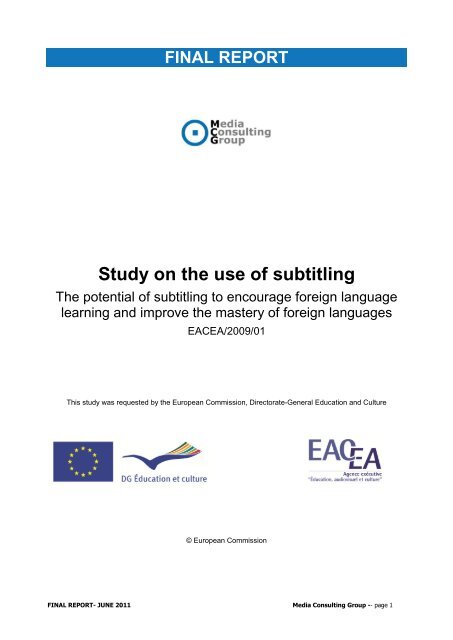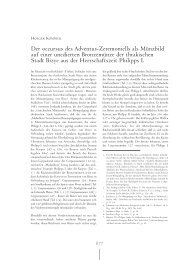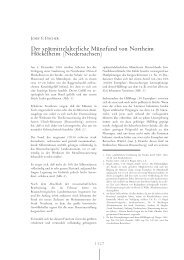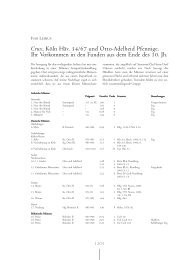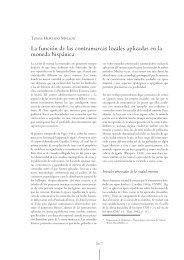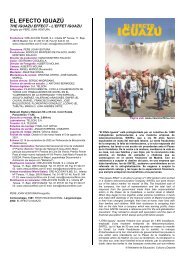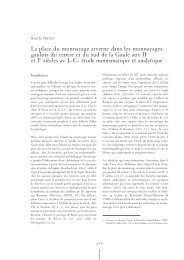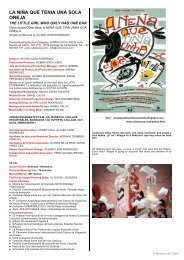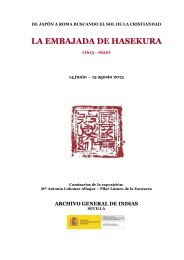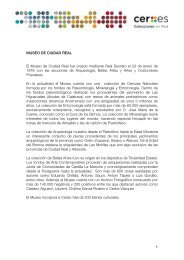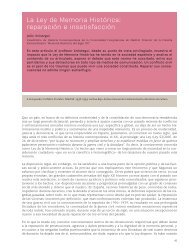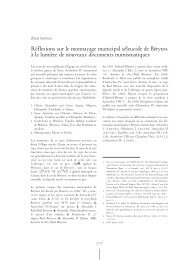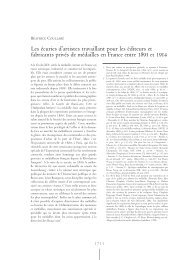Study on the use of subtitling
Study on the use of subtitling
Study on the use of subtitling
Create successful ePaper yourself
Turn your PDF publications into a flip-book with our unique Google optimized e-Paper software.
FINAL REPORT<br />
<str<strong>on</strong>g>Study</str<strong>on</strong>g> <strong>on</strong> <strong>the</strong> <strong>use</strong> <strong>of</strong> <strong>subtitling</strong><br />
The potential <strong>of</strong> <strong>subtitling</strong> to encourage foreign language<br />
learning and improve <strong>the</strong> mastery <strong>of</strong> foreign languages<br />
EACEA/2009/01<br />
This study was requested by <strong>the</strong> European Commissi<strong>on</strong>, Directorate-General Educati<strong>on</strong> and Culture<br />
© European Commissi<strong>on</strong><br />
FINAL REPORT- JUNE 2011 Media C<strong>on</strong>sulting Group -- page 1
The views expressed in this report are those <strong>of</strong> <strong>the</strong> authors and do not necessarily<br />
reflect <strong>the</strong> positi<strong>on</strong> <strong>of</strong> <strong>the</strong> European Commissi<strong>on</strong>.<br />
The team<br />
Hayssam Safar Centre for Multimedia Studies and Research,<br />
University <strong>of</strong> M<strong>on</strong>s, Belgium<br />
Project leader<br />
Alain Modot Media C<strong>on</strong>sulting Group, France Deputy project leader<br />
Silvia Angrisani Media C<strong>on</strong>sulting Group, France Coordinator <strong>of</strong> <strong>the</strong><br />
study<br />
Yves Gambier University <strong>of</strong> Turku, Finland Expert<br />
Carlo Eugeni University <strong>of</strong> Macerata, Italy Researcher<br />
Héloïse F<strong>on</strong>tanel Media C<strong>on</strong>sulting Group, France Researcher<br />
Najwa Hamaoui Centre for Multimedia Studies and Research,<br />
University <strong>of</strong> M<strong>on</strong>s, Belgium<br />
Xavier Verstrepen Centre for Multimedia Studies and Research,<br />
University <strong>of</strong> M<strong>on</strong>s, Belgium<br />
Researcher<br />
Researcher<br />
The team wishes to thank all those who participated in <strong>the</strong> survey as well as <strong>the</strong> experts who<br />
took part in <strong>the</strong> Brussels workshop for <strong>the</strong>ir generosity with <strong>the</strong>ir time and <strong>the</strong> quality <strong>of</strong> <strong>the</strong>ir<br />
c<strong>on</strong>tributi<strong>on</strong>s.<br />
For fur<strong>the</strong>r informati<strong>on</strong>, please c<strong>on</strong>tact: Media C<strong>on</strong>sulting Group, 18 Rue Séguier, 75006 Paris,<br />
France – Tel. (33) 1 55 42 73 00 – sa@mediacg.tv<br />
FINAL REPORT- JUNE 2011 Media C<strong>on</strong>sulting Group -- page 2
C<strong>on</strong>tents<br />
1 INTRODUCTION 4<br />
2 METHODOLOGY 5<br />
3 LANGUAGE TRANSFER PRACTICES IN THE MEDIA 6<br />
3.1 Map <strong>of</strong> language transfer practices in cinema 6<br />
3.2 Map <strong>of</strong> language transfer practices in televisi<strong>on</strong> 8<br />
4 THE ROLE OF SUBTITLING IN INFORMAL LEARNING CONTEXTS 10<br />
4.1 Impact <strong>of</strong> language transfer practices <strong>on</strong> <strong>the</strong> public's capacity to speak and/or understand foreign languages<br />
10<br />
4.2 Correlati<strong>on</strong> between countries with high levels <strong>of</strong> language skills and a traditi<strong>on</strong> <strong>of</strong> <strong>subtitling</strong> compared with<br />
dubbing 11<br />
5 THE ROLE OF SUBTITLING IN FORMAL LEARNING CONTEXTS 16<br />
5.1 Educati<strong>on</strong>al impact <strong>of</strong> spoken and written language <strong>on</strong> <strong>the</strong> screen <strong>on</strong> language laarning 16<br />
5.2 Knowledge <strong>of</strong> foreign languages and preference for dubbing or <strong>subtitling</strong> 18<br />
6 BARRIERS TO THE USE OF SUBTITLING 23<br />
7 CONCLUSIONS 26<br />
8 RECOMMENDATIONS 27<br />
8.1 Strategic recommendati<strong>on</strong>: Enhanced dialogue with all stakeholders 27<br />
8.2 Strategic recommendati<strong>on</strong>: A study <strong>of</strong> best practice 27<br />
8.3 Strategic recommendati<strong>on</strong>: Creati<strong>on</strong> <strong>of</strong> and awareness raising in networks <strong>of</strong> educators 28<br />
8.4 Strategic recommendati<strong>on</strong>: Involvement <strong>of</strong> media pr<strong>of</strong>essi<strong>on</strong>als 28<br />
A summary <strong>of</strong> this report and <strong>of</strong> its annexes is also available:<br />
Annex 1 - The c<strong>on</strong>text and methodology<br />
Annex 2 – Audiovisual transfer practices and barriers to <strong>the</strong> <strong>use</strong> <strong>of</strong> <strong>subtitling</strong><br />
Annex 3 – The role <strong>of</strong> <strong>subtitling</strong> in informal learning c<strong>on</strong>texts<br />
Annex 4 - The role <strong>of</strong> <strong>subtitling</strong> in formal learning c<strong>on</strong>texts<br />
Annex 5 – The questi<strong>on</strong>naire-based survey, country by country<br />
Annex 6 - References and sources <strong>of</strong> informati<strong>on</strong><br />
Annex 7 - Measures to maximise <strong>the</strong> study's visibility<br />
FINAL REPORT- JUNE 2011 Media C<strong>on</strong>sulting Group -- page 3
1 Introducti<strong>on</strong><br />
In various documents published between 2003 and 2008 1 , <strong>the</strong> European Commissi<strong>on</strong> presented<br />
its approach to developing multilingualism. The key measures outlined in <strong>the</strong>se texts include<br />
promoting language learning, linguistic diversity and a multilingual ec<strong>on</strong>omy, and improving<br />
access to legislati<strong>on</strong>, procedures and informati<strong>on</strong> <strong>on</strong> <strong>the</strong> European Uni<strong>on</strong> in citizens' own<br />
language.<br />
In September 2008, <strong>the</strong> Commissi<strong>on</strong> published its Communicati<strong>on</strong> <strong>on</strong> 'Multilingualism: an asset<br />
for Europe and a shared commitment' 2 . This paper emphasizes <strong>the</strong> c<strong>on</strong>tributi<strong>on</strong> that investing in<br />
language training can bring to individuals, enterprises and European society as a whole. It also<br />
points out that <strong>the</strong> media can be a rich source <strong>of</strong> informal language learning. The Commissi<strong>on</strong><br />
went <strong>on</strong> to launch in May 2010 a study aimed at analysing <strong>the</strong> potential <strong>of</strong> <strong>subtitling</strong> to<br />
encourage language learning and enhance foreign language skills.<br />
Durati<strong>on</strong><br />
The study took place over a 12-m<strong>on</strong>th period.<br />
Geographical scope<br />
The study covered <strong>the</strong> 27 Member States <strong>of</strong> <strong>the</strong> European Uni<strong>on</strong>, <strong>the</strong> three countries <strong>of</strong> <strong>the</strong><br />
European Ec<strong>on</strong>omic Area (Iceland, Norway and Liechtenstein), as well as Switzerland, Croatia<br />
and Turkey, making a total <strong>of</strong> 33 countries.<br />
Scope <strong>of</strong> <strong>the</strong> study<br />
In accordance with <strong>the</strong> tender specificati<strong>on</strong>s, <strong>the</strong> study foc<strong>use</strong>d <strong>on</strong> <strong>the</strong> following <strong>the</strong>mes:<br />
1. Descripti<strong>on</strong> <strong>of</strong> language transfer practices in <strong>the</strong> media<br />
2. Analysis <strong>of</strong> <strong>the</strong> impact <strong>of</strong> language transfer practices <strong>on</strong> <strong>the</strong> public's ability to speak<br />
and/or understand foreign languages<br />
3. Analysis <strong>of</strong> <strong>the</strong> correlati<strong>on</strong> between countries where <strong>the</strong>re are high levels <strong>of</strong> language<br />
skills and <strong>the</strong> traditi<strong>on</strong> <strong>of</strong> <strong>subtitling</strong> ra<strong>the</strong>r than dubbing<br />
4. Analysis <strong>of</strong> <strong>the</strong> relati<strong>on</strong> between knowledge <strong>of</strong> foreign languages and preference for<br />
dubbing or <strong>subtitling</strong><br />
5. Analysis <strong>of</strong> <strong>the</strong> role <strong>of</strong> <strong>subtitling</strong> as a catalyst for language learning<br />
6. Analysis <strong>of</strong> <strong>the</strong> educati<strong>on</strong>al impact <strong>of</strong> written and spoken language <strong>on</strong> <strong>the</strong> screen<br />
7. Analysis <strong>of</strong> <strong>the</strong> impact <strong>of</strong> <strong>subtitling</strong> <strong>on</strong> <strong>the</strong> integrati<strong>on</strong> <strong>of</strong> immigrants as a means for<br />
learning <strong>the</strong> language <strong>of</strong> <strong>the</strong> host country<br />
8. Identificati<strong>on</strong> <strong>of</strong> barriers to <strong>the</strong> <strong>use</strong> <strong>of</strong> <strong>subtitling</strong><br />
9. Analysis <strong>of</strong> <strong>the</strong> role <strong>of</strong> <strong>subtitling</strong> in building a language-friendly envir<strong>on</strong>ment in Europe<br />
1 'Promoting Language Learning and Linguistic Diversity : Acti<strong>on</strong> Plan 2004-2006'<br />
http://ec.europa.eu/educati<strong>on</strong>/languages/eu-language-policy/doc112_en.htm;<br />
'A New Framework Strategy for Multilingualism':<br />
http://eur-lex.europa.eu/LexUriServ/LexUriServ.do?uri=COM:2005:0596:FIN:EN:PDF;<br />
Final Report <strong>of</strong> High Level Group <strong>on</strong> Multilingualism:<br />
http://ec.europa.eu/educati<strong>on</strong>/policies/lang/doc/multireport_en.pdf;<br />
2 Communicati<strong>on</strong> <strong>on</strong> 'Multilingualism: an asset for Europe and a shared commitment'<br />
http://ec.europa.eu/educati<strong>on</strong>/languages/pdf/com/2008_0566_en.pdf<br />
FINAL REPORT- JUNE 2011 Media C<strong>on</strong>sulting Group -- page 4
2 Methodology<br />
The study was c<strong>on</strong>ducted using <strong>the</strong> following methodological tools: documentary research,<br />
questi<strong>on</strong>naire-based surveys and case studies.<br />
Two questi<strong>on</strong>naire-based surveys were c<strong>on</strong>ducted:<br />
� <strong>the</strong> first addressed <strong>the</strong>mes 2, 3, 5, 6, 7 and 9 menti<strong>on</strong>ed in <strong>the</strong> above secti<strong>on</strong>. This<br />
survey targeted a European public divided into three age groups: teenagers aged 12 to<br />
18, young adults aged 18 to 25, and adults over <strong>the</strong> age <strong>of</strong> 25. A sample <strong>of</strong> around 50<br />
people was targeted for each age group, giving a total <strong>of</strong> at least 150 people in each <strong>of</strong><br />
<strong>the</strong> 33 countries covered by <strong>the</strong> study. The entire sample <strong>the</strong>refore included 5 966<br />
individuals. In additi<strong>on</strong> to <strong>the</strong>se three age groups, three categories were sampled in<br />
Belgium: European affairs pr<strong>of</strong>essi<strong>on</strong>als, young people aged 25 to 35 looking for a job 3<br />
and immigrants, with 50 pers<strong>on</strong>s surveyed in each <strong>of</strong> <strong>the</strong> latter two categories.<br />
o The questi<strong>on</strong>naires were distributed through several channels: a special purpose<br />
website (www.european<strong>subtitling</strong>.eu); two discussi<strong>on</strong> forums, <strong>on</strong>e <strong>on</strong> Facebook and<br />
a sec<strong>on</strong>d <strong>on</strong> LinkedIn; <strong>the</strong> cultural services <strong>of</strong> embassies; <strong>the</strong> European School in<br />
Brussels; 60 'student delegates' <strong>of</strong> <strong>the</strong> Centre for Multimedia Studies and Research<br />
at University <strong>of</strong> M<strong>on</strong>s, Belgium; pr<strong>of</strong>essi<strong>on</strong>al associati<strong>on</strong>s such as <strong>the</strong> Internati<strong>on</strong>al<br />
Federati<strong>on</strong> <strong>of</strong> Translators (IFT), <strong>the</strong> Internati<strong>on</strong>al Associati<strong>on</strong> <strong>of</strong> C<strong>on</strong>ference<br />
Interpreters (AIIC - Associati<strong>on</strong> Internati<strong>on</strong>ale des Interprètes de C<strong>on</strong>férence), <strong>the</strong><br />
Internati<strong>on</strong>al Permanent C<strong>on</strong>ference <strong>of</strong> University Institutes for Translati<strong>on</strong> and<br />
Interpretati<strong>on</strong> Studies (CIUTI - C<strong>on</strong>férence Internati<strong>on</strong>ale Permanente des Instituts<br />
Universitaires de Traducti<strong>on</strong> et d’Interprétati<strong>on</strong>); and Media C<strong>on</strong>sulting Group's<br />
networks <strong>of</strong> media pr<strong>of</strong>essi<strong>on</strong>als.<br />
o The large size <strong>of</strong> <strong>the</strong> sample ensured reliable results and analysis <strong>of</strong> <strong>the</strong> findings<br />
under <strong>the</strong> statistical inference 4 method.<br />
� <strong>the</strong> sec<strong>on</strong>d survey foc<strong>use</strong>d <strong>on</strong> <strong>the</strong>me 4. Two sample groups were created, independent<br />
from those <strong>of</strong> <strong>the</strong> first survey: a focus group made up <strong>of</strong> foreign language students and a<br />
c<strong>on</strong>trol group made up <strong>of</strong> students enrolled in n<strong>on</strong>-language faculties. There were around<br />
5 000 resp<strong>on</strong>dents in <strong>the</strong> sample as a whole, 3 122 in <strong>the</strong> focus group and 1 850 in <strong>the</strong><br />
c<strong>on</strong>trol group.<br />
o The questi<strong>on</strong>naire was distributed with <strong>the</strong> collaborati<strong>on</strong> <strong>of</strong> foreign language<br />
pr<strong>of</strong>essors from different universities in Europe and via social networks like<br />
Facebook.<br />
The case studies were <strong>use</strong>d for <strong>the</strong>mes 1, 5, 6 and 7.<br />
'Europe 33': all <strong>the</strong> countries covered by <strong>the</strong> study.<br />
Glossary<br />
'Interlinguistic <strong>subtitling</strong>': a film in a foreign language subtitled in <strong>the</strong> learner's language<br />
'Intralinguistic <strong>subtitling</strong>': a film subtitled in <strong>the</strong> same language as <strong>the</strong> original<br />
'Reverse <strong>subtitling</strong>': a film in <strong>the</strong> learner's mo<strong>the</strong>r t<strong>on</strong>gue, subtitled in a foreign language<br />
'Formal learning c<strong>on</strong>texts' and 'Informal learning c<strong>on</strong>texts': formal c<strong>on</strong>texts are those where structured<br />
learning takes place through <strong>the</strong> support <strong>of</strong> a teacher or tutor, and in a special purpose instituti<strong>on</strong>. Informal<br />
c<strong>on</strong>texts are those where language learning is indirect and can result ei<strong>the</strong>r from a voluntary initiative or<br />
from sp<strong>on</strong>taneous and unc<strong>on</strong>trolled acquisiti<strong>on</strong>. Informal c<strong>on</strong>texts are envir<strong>on</strong>ments that do not have<br />
educati<strong>on</strong>al aims.<br />
3 See case study in Annex 4.<br />
4 For more informati<strong>on</strong> <strong>on</strong> <strong>the</strong> methodology, see Annex1.<br />
FINAL REPORT- JUNE 2011 Media C<strong>on</strong>sulting Group -- page 5
3 Language transfer practices in<br />
<strong>the</strong> media<br />
Three main language transfer practices exist side by side in Europe for audiovisual works:<br />
<strong>subtitling</strong>, dubbing and voice-over. In additi<strong>on</strong> to <strong>the</strong>se practices <strong>the</strong>re are also self-descripti<strong>on</strong>,<br />
intended for blind or sight-impaired viewers, and <strong>subtitling</strong> for <strong>the</strong> deaf or hearing-impaired,<br />
which has specific characteristics that make it suited to <strong>the</strong> needs <strong>of</strong> this segment <strong>of</strong> <strong>the</strong><br />
populati<strong>on</strong>.<br />
These techniques are <strong>use</strong>d to translate foreign audiovisual works (films, documentaries, ficti<strong>on</strong><br />
and animati<strong>on</strong>) into <strong>the</strong> nati<strong>on</strong>al language.<br />
Language transfer practices vary not <strong>on</strong>ly from <strong>on</strong>e country to <strong>the</strong> next, but sometimes vary<br />
within <strong>the</strong> same country depending <strong>on</strong> <strong>the</strong> broadcast medium (cinema or televisi<strong>on</strong>) or <strong>the</strong> target<br />
public (general public, cinema-enthusiast public, young people, public with accessibility<br />
problems).<br />
The two maps presented in <strong>the</strong> following secti<strong>on</strong>s show <strong>the</strong> distributi<strong>on</strong> <strong>of</strong> language transfer<br />
practices by country for cinema and televisi<strong>on</strong>. They identify distinct categories <strong>of</strong> '<strong>subtitling</strong><br />
countries', 'dubbing countries', 'voice-over countries' and 'mixed-practices countries'. It should<br />
never<strong>the</strong>less be borne in mind that <strong>the</strong> volume <strong>of</strong> c<strong>on</strong>tent to be translated depends <strong>on</strong> <strong>the</strong><br />
number <strong>of</strong> audiovisual works in foreign languages circulating in each country 5 .<br />
To give a few examples, 503 films were released in cinemas in <strong>the</strong> United Kingdom in 2009 6 , <strong>of</strong><br />
which 113 nati<strong>on</strong>al films and 212 US films, for a total <strong>of</strong> 325 films in English 7 . Therefore <strong>on</strong>ly<br />
35% <strong>of</strong> films released in cinemas needed translati<strong>on</strong>, which explains why <strong>the</strong> presence <strong>of</strong><br />
subtitled films may not be highly visible in this '<strong>subtitling</strong>' country'. At <strong>the</strong> opposite extreme are<br />
countries like Bulgaria, Belgium, Croatia, Est<strong>on</strong>ia and Iceland, where more than 90% <strong>of</strong> films<br />
require translati<strong>on</strong>. In <strong>the</strong>se countries, nati<strong>on</strong>al films represent a very small percentage <strong>of</strong> films<br />
released in cinemas and <strong>the</strong> <strong>use</strong> <strong>of</strong> <strong>subtitling</strong> is much more visible than in <strong>the</strong> United Kingdom.<br />
In countries where nati<strong>on</strong>al films make up a large comp<strong>on</strong>ent <strong>of</strong> films <strong>on</strong> <strong>of</strong>fer, <strong>the</strong> percentage <strong>of</strong><br />
films to be translated decreases: this is <strong>the</strong> case in France (around 54%) and to a lesser extent<br />
in Italy (around 68%).<br />
For televisi<strong>on</strong> broadcasting, <strong>the</strong> percentage <strong>of</strong> hours to be dubbed or subtitled also differs from<br />
<strong>on</strong>e country to ano<strong>the</strong>r: it is very low in <strong>the</strong> United Kingdom (around 23%) and much higher in<br />
Flemish-speaking Belgium, Denmark, Norway and Sweden, where it accounts for more than<br />
90% <strong>of</strong> programming time 8 .<br />
3.1 Map <strong>of</strong> language transfer practices in cinema<br />
Subtitling is <strong>the</strong> language transfer practice <strong>use</strong>d most widely in Europe. It c<strong>on</strong>cerns 28 countries<br />
(26 countries plus two regi<strong>on</strong>s in two countries): Belgium (Flemish-speaking), Bulgaria, Croatia,<br />
Cyprus, Czech Republic, Denmark, Est<strong>on</strong>ia, Finland, Greece, Hungary, Iceland, Ireland, Latvia,<br />
Liechtenstein, Lithuania, Luxembourg, Malta, Ne<strong>the</strong>rlands, Norway, Poland, Portugal, Romania,<br />
Slovakia, Slovenia, Sweden, Switzerland (German-speaking), Turkey and United Kingdom.<br />
5<br />
See Annex 2 for an overall table <strong>of</strong> <strong>the</strong> circulati<strong>on</strong> <strong>of</strong> films (in cinemas) in Europe.<br />
6<br />
According to data from <strong>the</strong> European Audiovisual Observatory, Yearbook 2010. These data include<br />
Ireland.<br />
7<br />
Allowing for excepti<strong>on</strong>s.<br />
8<br />
Annex 2 c<strong>on</strong>tains an overall table <strong>of</strong> <strong>the</strong> hourly volume <strong>of</strong> audiovisual (TV) c<strong>on</strong>tent in Europe.<br />
FINAL REPORT- JUNE 2011 Media C<strong>on</strong>sulting Group -- page 6
Dubbing is <strong>the</strong> predominant language transfer practice in Spain, Italy, Germany, Austria,<br />
Belgium (French-speaking) and Switzerland (French- and Italian-speaking). It is also <strong>use</strong>d widely<br />
in France. Dubbing is <strong>use</strong>d to different extents in <strong>the</strong>se countries.<br />
In Spain, dubbing is <strong>the</strong> dominant practice for both European and American films. Of <strong>the</strong> total<br />
number <strong>of</strong> European box-<strong>of</strong>fice release films in 2009, 53% were released <strong>on</strong>ly in a dubbed<br />
versi<strong>on</strong> and 29% in both (dubbed and subtitled). The share <strong>of</strong> American films released <strong>on</strong>ly in a<br />
dubbed versi<strong>on</strong> is still higher, accounting for 69% <strong>of</strong> <strong>the</strong> total 9 . Spain is made up <strong>of</strong> aut<strong>on</strong>omous<br />
communities, each <strong>of</strong> which has an <strong>of</strong>ficial language o<strong>the</strong>r than Spanish. Some <strong>of</strong> <strong>the</strong>se<br />
communities have specific language transfer practices. In Catal<strong>on</strong>ia, for example, <strong>the</strong> 'Ley del<br />
Ciné Catalàn' (Catalan Cinema Act) adopted by <strong>the</strong> Aut<strong>on</strong>omous Parliament <strong>of</strong> Catal<strong>on</strong>ia <strong>on</strong> 30<br />
June 2010, establishes that a foreign film released to box <strong>of</strong>fices must have <strong>the</strong> same<br />
percentage <strong>of</strong> prints dubbed in Catalan as in Spanish.<br />
In Italy, dubbing is still <strong>the</strong> dominant practice (around 89% <strong>of</strong> European films and 63% <strong>of</strong> US<br />
films), although certain films are also released in a subtitled versi<strong>on</strong> 10 .<br />
In France, <strong>the</strong> most widespread practice is <strong>the</strong> dual versi<strong>on</strong>: foreign films, whe<strong>the</strong>r European or<br />
American, are generally released in a number <strong>of</strong> subtitled prints and ano<strong>the</strong>r porti<strong>on</strong> in dubbed<br />
versi<strong>on</strong> 11 . However, a very small percentage <strong>of</strong> cinemas programme <strong>the</strong> films in both versi<strong>on</strong>s<br />
(3.5% for European films and 2.3% for American films). Most programme films with dubbing<br />
(around 53% <strong>of</strong> cinemas for European films and 82% for American films). It can <strong>the</strong>refore be<br />
argued that <strong>the</strong> populati<strong>on</strong> is exposed to a large extent to dubbing ra<strong>the</strong>r than <strong>subtitling</strong> 12 .<br />
In Germany, dubbing is <strong>the</strong> general rule but some films are released in both dubbed and<br />
subtitled versi<strong>on</strong>s. Subtitling seems to meet <strong>the</strong> demands <strong>of</strong> certain segments <strong>of</strong> <strong>the</strong> public,<br />
particularly for artho<strong>use</strong> films. In Austria, practices are similar to those in Germany. Hungary,<br />
traditi<strong>on</strong>ally a dubbing country, is increasingly turning to <strong>subtitling</strong>, although dubbing remains <strong>the</strong><br />
most widespread practice for televisi<strong>on</strong> broadcasting.<br />
The Czech Republic is increasingly shifting to <strong>subtitling</strong>: European films released in 2009 were<br />
all in <strong>the</strong> original language with subtitles; American films were released mostly in <strong>the</strong> original with<br />
subtitles (around 75%) and a minority in both subtitled and dubbed versi<strong>on</strong>s (around 25%) 13 .<br />
Croatia is a <strong>subtitling</strong> country, although a small number <strong>of</strong> foreign films are distributed in dubbed<br />
versi<strong>on</strong> or in both dubbed and subtitled versi<strong>on</strong>s 14 .<br />
So-called '<strong>subtitling</strong> countries' do not c<strong>on</strong>stitute a uniform bloc. Bilingual <strong>subtitling</strong> is <strong>use</strong>d in<br />
some <strong>of</strong> <strong>the</strong>se countries: this is <strong>the</strong> case in Flemish-speaking Belgium, where films are subtitled<br />
in French and Flemish; Finland (<strong>subtitling</strong> in Finnish and Swedish); Luxembourg (<strong>subtitling</strong> in<br />
French and Dutch or German); and Switzerland, for subtitled versi<strong>on</strong>s in French- and Germanspeaking<br />
Switzerland (French and German). Switzerland is a special case in fact: French- and<br />
Italian-speaking Swiss prefer dubbing whereas German-speaking Switzerland tends to <strong>use</strong><br />
<strong>subtitling</strong> more <strong>of</strong>ten. A number <strong>of</strong> films are distributed in <strong>the</strong> original, moreover, with release<br />
limited to <strong>the</strong>ir language regi<strong>on</strong> (French films in French-speaking Switzerland, German or<br />
Austrian films in German-speaking Switzerland and Italian films in Ticino).<br />
9<br />
Source: Instituto de la Cinematografía y de las Artes Audiovisuales, Spain.<br />
10<br />
Source: Cinecittà Luce, Italy.<br />
11<br />
Source: Centre nati<strong>on</strong>al du cinéma et de l’image animée, France. Data for films released in 2009.<br />
12<br />
For more detailed informati<strong>on</strong>, see Annex 2.<br />
13<br />
Source: Czech Ministry <strong>of</strong> Culture. The data collected c<strong>on</strong>cern <strong>on</strong>ly first commercial exploitati<strong>on</strong> films.<br />
14 Source: Croatian Audiovisual Centre.<br />
FINAL REPORT- JUNE 2011 Media C<strong>on</strong>sulting Group -- page 7
Subtitling<br />
Dubbing<br />
Both versi<strong>on</strong>s (subtitled and dubbed prints)<br />
3.2 Map <strong>of</strong> language transfer practices in televisi<strong>on</strong><br />
Dubbing is <strong>the</strong> dominant practice in 11 countries: Austria, Belgium (French-speaking), Czech<br />
Republic, France, Germany, Hungary, Italy, Slovakia, Spain, Switzerland and Turkey.<br />
Voice-over is practiced in four countries: Bulgaria, Poland, Latvia and Lithuania. It is practiced to<br />
a lesser extent in Est<strong>on</strong>ia as well, where <strong>on</strong>e third <strong>of</strong> programmes are broadcast in voice-over<br />
and <strong>the</strong> remainder with subtitles.<br />
Subtitling is practiced in <strong>the</strong> remainder <strong>of</strong> <strong>the</strong> countries: Belgium (Flemish-speaking), Croatia,<br />
Cyprus, Denmark, Est<strong>on</strong>ia, Finland, Greece, Iceland, Ireland, Ne<strong>the</strong>rlands, Norway, Portugal,<br />
Romania, Slovenia, Sweden and United Kingdom.<br />
Luxembourg and Malta fall into a separate category. In Luxembourg, <strong>the</strong> audiovisual landscape<br />
is shared by <strong>the</strong> nati<strong>on</strong>al group RTL and foreign broadcasters. The foreign channels broadcast<br />
in <strong>the</strong> nati<strong>on</strong>al language <strong>of</strong> <strong>the</strong>ir country <strong>of</strong> origin; channels that bel<strong>on</strong>g to RTL group broadcast<br />
in French, German or Dutch, depending <strong>on</strong> <strong>the</strong> target public. RTL Lëtzeuberg is <strong>the</strong> <strong>on</strong>ly channel<br />
that broadcasts in Luxembourgish. In Malta, <strong>the</strong> language <strong>of</strong> broadcast is Maltese; foreign films<br />
FINAL REPORT- JUNE 2011 Media C<strong>on</strong>sulting Group -- page 8
are broadcast directly in an English versi<strong>on</strong> (or sometimes in an Italian versi<strong>on</strong> <strong>on</strong> Italian<br />
channels).<br />
Digital broadcasting is starting to change <strong>the</strong> audiovisual envir<strong>on</strong>ment, giving TV viewers access<br />
to original versi<strong>on</strong>s with subtitles as alternatives to dubbed versi<strong>on</strong>s, or to <strong>subtitling</strong> in a<br />
language o<strong>the</strong>r than <strong>the</strong> main language <strong>of</strong> broadcast. This opti<strong>on</strong> is a possibility in a number <strong>of</strong><br />
countries, but for now <strong>on</strong>ly c<strong>on</strong>cerns certain channels for certain programmes, due to<br />
technological and ec<strong>on</strong>omic barriers 15 .<br />
Subtitling<br />
Dubbing<br />
Voice-over<br />
Originals<br />
15 See Annex 2, in particular <strong>the</strong> case study <strong>on</strong> televisi<strong>on</strong> channels.<br />
FINAL REPORT- JUNE 2011 Media C<strong>on</strong>sulting Group -- page 9
4 The role <strong>of</strong> <strong>subtitling</strong> in<br />
informal learning c<strong>on</strong>texts<br />
4.1 Impact <strong>of</strong> language transfer practices <strong>on</strong> <strong>the</strong> populati<strong>on</strong>'s capacity<br />
to speak and/or understand foreign languages<br />
Foreign language skills vary from <strong>on</strong>e country to <strong>the</strong> next and also sometimes from <strong>on</strong>e regi<strong>on</strong> to<br />
<strong>the</strong> next in <strong>the</strong> same country. In Belgium, for example, English is <strong>the</strong> sec<strong>on</strong>d language in<br />
Wall<strong>on</strong>ia and Brussels (where it is mastered by 20% and 36% <strong>of</strong> <strong>the</strong> populati<strong>on</strong> respectively),<br />
outdistancing Flemish. By c<strong>on</strong>trast, French is still <strong>the</strong> sec<strong>on</strong>d language in Flanders, coming<br />
slightly ahead <strong>of</strong> English. German ranks third in <strong>the</strong> country's three regi<strong>on</strong>s. Analysis <strong>of</strong> <strong>the</strong><br />
questi<strong>on</strong>naires shows that <strong>the</strong> different language transfer practices <strong>use</strong>d in <strong>the</strong>se three regi<strong>on</strong>s<br />
make up <strong>on</strong>e <strong>of</strong> <strong>the</strong> variables that influence <strong>the</strong> capacity to speak foreign languages.<br />
The results at European level (Europe 33) show that, in <strong>the</strong> over-25 age group, <strong>the</strong> majority <strong>of</strong><br />
resp<strong>on</strong>dents speak a sec<strong>on</strong>d language al<strong>on</strong>g with <strong>the</strong>ir mo<strong>the</strong>r t<strong>on</strong>gue (around 53%), whereas<br />
<strong>the</strong> sub-groups <strong>of</strong> those mastering three or four languages are smaller, representing 21% and<br />
9% respectively <strong>of</strong> those surveyed. In <strong>the</strong> 18-25 age group, <strong>the</strong> percentages change<br />
significantly: 69.5% <strong>of</strong> resp<strong>on</strong>dents master a sec<strong>on</strong>d language, 39% a third language and 12% a<br />
fourth language. In <strong>the</strong> 12-18 age group, made up mostly <strong>of</strong> sec<strong>on</strong>dary school pupils, 66%<br />
master a sec<strong>on</strong>d language, 17% a third language and 5% a fourth, whereas 5% speak <strong>on</strong>ly <strong>the</strong>ir<br />
mo<strong>the</strong>r t<strong>on</strong>gue.<br />
These figures were compared with <strong>the</strong> answers given to o<strong>the</strong>r questi<strong>on</strong>s (frequency <strong>of</strong> viewing<br />
films and audiovisual programmes in <strong>the</strong> different media; whe<strong>the</strong>r <strong>the</strong> viewer is accustomed to<br />
<strong>the</strong> <strong>use</strong> <strong>of</strong> <strong>subtitling</strong>; preference for ei<strong>the</strong>r <strong>subtitling</strong> or dubbing; willingness to watch audiovisual<br />
programmes with subtitles) and analysed in relati<strong>on</strong> to <strong>the</strong> audiovisual language transfer practice<br />
<strong>use</strong>d in each country. A comparative analysis was also made using as <strong>the</strong> term <strong>of</strong> comparis<strong>on</strong><br />
<strong>the</strong> sample <strong>of</strong> European civil servants, whose foreign language skills are particularly high 16 .<br />
The results <strong>of</strong> <strong>the</strong>se analyses should be interpreted cautiously beca<strong>use</strong> language skills levels<br />
are self-assessed (resp<strong>on</strong>dents evaluated <strong>the</strong>ir own knowledge <strong>of</strong> languages). They suggest<br />
three main avenues to be fur<strong>the</strong>r explored:<br />
� There is no negative correlati<strong>on</strong> between being accustomed to dubbing and knowledge <strong>of</strong><br />
foreign languages: <strong>the</strong> populati<strong>on</strong>s <strong>of</strong> dubbing countries speak o<strong>the</strong>r languages in<br />
additi<strong>on</strong> to <strong>the</strong>ir mo<strong>the</strong>r t<strong>on</strong>gue. However, <strong>the</strong> populati<strong>on</strong>s <strong>of</strong> dubbing countries do not<br />
speak more foreign languages than those <strong>of</strong> <strong>subtitling</strong> countries in any <strong>of</strong> <strong>the</strong> three age<br />
groups surveyed.<br />
� A correlati<strong>on</strong> seems to exist between age, number <strong>of</strong> languages spoken and preference<br />
for <strong>subtitling</strong> or dubbing: <strong>the</strong> younger <strong>the</strong> resp<strong>on</strong>dents (aged 12-18 and 18-25) and <strong>the</strong><br />
more languages <strong>the</strong>y speak, <strong>the</strong> more pr<strong>on</strong>ounced is <strong>the</strong>ir preference for <strong>subtitling</strong> over<br />
dubbing.<br />
� In additi<strong>on</strong>, both <strong>the</strong> 12-18 and 18-25 age groups are c<strong>on</strong>vinced that <strong>subtitling</strong> is an<br />
effective tool for language learning, unlike <strong>the</strong> over-25 sample group, who have more<br />
doubts about <strong>the</strong> effectiveness <strong>of</strong> <strong>subtitling</strong> from <strong>the</strong> educati<strong>on</strong>al point <strong>of</strong> view.<br />
16 See Annex 3.<br />
FINAL REPORT- JUNE 2011 Media C<strong>on</strong>sulting Group -- page 10
4.2 Correlati<strong>on</strong> between countries with high levels <strong>of</strong> language skills<br />
and <strong>the</strong> traditi<strong>on</strong> <strong>of</strong> <strong>subtitling</strong> ra<strong>the</strong>r than dubbing<br />
A 'high level <strong>of</strong> language skills' can be defined by two separate parameters:<br />
� from a quantitative point <strong>of</strong> view, it can indicate <strong>the</strong> number <strong>of</strong> subjects whose knowledge<br />
<strong>of</strong> a sec<strong>on</strong>d (L2) and third (L3) language is close to mo<strong>the</strong>r-t<strong>on</strong>gue (L1) level<br />
� from a qualitative point <strong>of</strong> view, it can indicate mastery <strong>of</strong> <strong>the</strong> language by each subject.<br />
In our survey, this mastery is assessed by each subject answering <strong>the</strong> questi<strong>on</strong>naire.<br />
Before detailing <strong>the</strong> results <strong>of</strong> <strong>the</strong> survey, it is <strong>use</strong>ful to point out that self-evaluati<strong>on</strong> by<br />
resp<strong>on</strong>dents <strong>of</strong> <strong>the</strong>ir own language skills may be influenced by representati<strong>on</strong>s specific to each<br />
culture (for example, depending <strong>on</strong> <strong>the</strong> country, some languages have <strong>the</strong> reputati<strong>on</strong> <strong>of</strong> being<br />
'easy' while o<strong>the</strong>rs tend to be c<strong>on</strong>sidered 'hard to learn'. These cultural representati<strong>on</strong>s can<br />
come into play in a self-evaluati<strong>on</strong> <strong>of</strong> language skills 17 .<br />
According to <strong>the</strong> survey results, in countries with a traditi<strong>on</strong> <strong>of</strong> <strong>subtitling</strong>, <strong>the</strong> majority <strong>of</strong><br />
resp<strong>on</strong>dents state that <strong>the</strong>ir language level (particularly in English) is close to mo<strong>the</strong>r-t<strong>on</strong>gue<br />
level, i.e. a level <strong>of</strong> 4 or 5 <strong>on</strong> a scale <strong>of</strong> 5, whereas in countries with a traditi<strong>on</strong> <strong>of</strong> dubbing, <strong>the</strong><br />
majority <strong>of</strong> resp<strong>on</strong>dents evaluate <strong>the</strong>ir level at 3 <strong>on</strong> a scale <strong>of</strong> 5.<br />
The survey shows that five countries achieve <strong>the</strong> best results in terms <strong>of</strong> 'high language level':<br />
Denmark, Finland, Ne<strong>the</strong>rlands, Norway and Sweden. An average <strong>of</strong> 86.5% <strong>of</strong> <strong>the</strong> populati<strong>on</strong><br />
surveyed in <strong>the</strong>se countries master <strong>the</strong> sec<strong>on</strong>d language and 41.4% <strong>the</strong> third language (i.e.<br />
96.7% <strong>of</strong> L2 and 49.8% <strong>of</strong> L3 for <strong>the</strong> group <strong>of</strong> subjects aged 25 and over, 93.5% <strong>of</strong> L2 and<br />
44.5% <strong>of</strong> L3 for <strong>the</strong> 18-25 group and 69.3% <strong>of</strong> L2 and 30% <strong>of</strong> L3 for <strong>the</strong> 12-18 group).<br />
Resp<strong>on</strong>dents state 18 that <strong>the</strong>ir language level (particularly in English) is close to mo<strong>the</strong>r-t<strong>on</strong>gue<br />
level, i.e. a level <strong>of</strong> 4 or 5 <strong>on</strong> a scale <strong>of</strong> 5.<br />
In countries with a traditi<strong>on</strong> <strong>of</strong> dubbing and voice-over, 73% <strong>of</strong> those surveyed said <strong>the</strong>y have an<br />
L2 and 28% an L3 (i.e. 63% <strong>of</strong> <strong>the</strong> subjects aged 25 and over have L2 and 22% L3. For <strong>the</strong> 18-<br />
25 age group, 78.7% have an L2 and 46% an L3. For <strong>the</strong> 12-18 age group, 77.6% L2 and 17%<br />
L3) 19 . Since <strong>the</strong> margin <strong>of</strong> error is very low, this spread seems to indicate a relati<strong>on</strong> between <strong>the</strong><br />
practice <strong>of</strong> <strong>subtitling</strong> in countries and high levels <strong>of</strong> language skills.<br />
17 See footnote in page 17.<br />
18 In <strong>the</strong> 15 <strong>subtitling</strong> countries (Belgium (Flemish-speaking), Croatia, Cyprus (Greek-speaking), Denmark,<br />
Est<strong>on</strong>ia, Finland, Greece, Iceland, Ne<strong>the</strong>rlands, Norway, Portugal, Romania, Slovenia, Sweden and<br />
United Kingdom) for <strong>the</strong> over-25 age group, 74.6% <strong>of</strong> subjects stated that <strong>the</strong>y have an L2, and 33% an<br />
L3. For <strong>the</strong> 18-25 age group, 80.7% said that <strong>the</strong>y have an L2 and 41.2% a third language. For <strong>the</strong> 12-18<br />
age group, <strong>the</strong> percentages are 72.5% for L2 and 22.7% for L3, or an average <strong>of</strong> 76% in this group <strong>of</strong><br />
countries for L2 and 32.3% for L3.<br />
19 It became apparent during <strong>the</strong> survey that many pers<strong>on</strong>s in <strong>the</strong> group <strong>of</strong> dubbing and voice-over<br />
countries c<strong>on</strong>sider that <strong>the</strong>y have an L2 and an L3 but do not always have points <strong>of</strong> references for judging<br />
<strong>the</strong>ir language skills levels as in <strong>subtitling</strong> countries.<br />
FINAL REPORT- JUNE 2011 Media C<strong>on</strong>sulting Group -- page 11
L 2 / Mo<strong>the</strong>r t<strong>on</strong>gue<br />
12 – 18<br />
L 2 / Mo<strong>the</strong>r t<strong>on</strong>gue<br />
18-25<br />
L 2 / Mo<strong>the</strong>r t<strong>on</strong>gue<br />
FINAL REPORT- JUNE 2011 Media C<strong>on</strong>sulting Group -- page 12<br />
+ 25<br />
Denmark 53/58 32/46 48/48<br />
Finland 32/50 44/44 42/44<br />
Ne<strong>the</strong>rlands 46/52 45/46 52/61<br />
Sweden 30/60 60/60 63/61<br />
Norway 29/54 50/51 55/55<br />
Figure 1 – Table <strong>of</strong> sec<strong>on</strong>d language volume by age group, taking <strong>the</strong> mo<strong>the</strong>r t<strong>on</strong>gue as <strong>the</strong> standard <strong>of</strong><br />
comparis<strong>on</strong> for <strong>the</strong> five 'top scoring' countries, by way <strong>of</strong> example<br />
In <strong>the</strong> following tables, it is possible to compare by age group <strong>the</strong> countries whose populati<strong>on</strong>,<br />
according to <strong>the</strong> survey, masters <strong>the</strong> mo<strong>the</strong>r t<strong>on</strong>gue (L1) + <strong>on</strong>e foreign language (L2) and those<br />
where <strong>the</strong> populati<strong>on</strong> has additi<strong>on</strong>al language skills, i.e. a sec<strong>on</strong>d foreign language.<br />
The over-25 age group<br />
The table below shows that at Europe 33 level, out <strong>of</strong> a sample <strong>of</strong> 2 277 subjects aged over 25<br />
years, an average <strong>of</strong> 37 out <strong>of</strong> 54 subjects per country master a sec<strong>on</strong>d language.
Over-25 age group Total resp<strong>on</strong>ses: 2277 Average: 69<br />
5. What is your mo<strong>the</strong>r t<strong>on</strong>gue? 6. Do you speak <strong>on</strong>e or more o<strong>the</strong>r languages?<br />
Country Resp<strong>on</strong>ses<br />
Mo<strong>the</strong>r t<strong>on</strong>gue Language 1 Language 2 Language 3 No<br />
Austria 48 40 12 2 2<br />
Belgium 88 59 33 6 6<br />
Bulgaria 48 18 3 1<br />
Cyprus 43 21 6 1<br />
Czech Republic 48 27 11 2 9<br />
Denmark 48 48 40 17<br />
Est<strong>on</strong>ia 46 21 7 2 1<br />
Finland 44 42 22 8<br />
France 86 59 18 16 23<br />
Germany 61 50 19 11 3<br />
Greece 48 31 19 7<br />
Hungary 51 24 11 2 5<br />
Ireland 40 30 6 2<br />
Italy 90 55 20 9 2<br />
Latvia 47 17 11 3<br />
Lithuania 47 19 7 1<br />
Luxembourg 44 45 17 10 4<br />
Malta 49 21 12 6<br />
Ne<strong>the</strong>rlands 61 52 14 9 5<br />
Poland 47 21 2<br />
Portugal 39 20 9 3 3<br />
Romania 43 40 7 3<br />
Slovakia 47 26 9 2 11<br />
Slovenia 52 31 13 7 1<br />
Spain 88 80 26 14 12<br />
Sweden 61 63 30 14 3<br />
United Kingdom 71 38 14 19 21<br />
Croatia 55 29 11 3 2<br />
Iceland 47 40 11 9 3<br />
Liechtenstein 51 33 11 3<br />
Norway 55 55 28 11 3<br />
Switzerland 29 14 8 5<br />
Turkey 52 39 8 2 8<br />
Total 1774 1208 473 208 131<br />
Average 54 37 14 6 4<br />
Figure 2 – Mo<strong>the</strong>r t<strong>on</strong>gue / Foreign languages. Populati<strong>on</strong> over age 25<br />
The result <strong>of</strong> 37/54, or 68.5%, represents a percentage that should give rise to a positive<br />
correlati<strong>on</strong> with a traditi<strong>on</strong> <strong>of</strong> <strong>subtitling</strong>. This is <strong>the</strong> situati<strong>on</strong> for many countries 20 although <strong>the</strong>re<br />
are o<strong>the</strong>rs for which this is not yet <strong>the</strong> case. These countries, such as <strong>the</strong> United Kingdom or<br />
Portugal, are described by Eurobarometer as 'm<strong>on</strong>olingual'. The majority <strong>of</strong> subjects in <strong>the</strong><br />
20 See country-by-country analysis in Annex 5.<br />
FINAL REPORT- JUNE 2011 Media C<strong>on</strong>sulting Group -- page 13
sample from Portugal resp<strong>on</strong>ded in a language o<strong>the</strong>r than <strong>the</strong>ir mo<strong>the</strong>r t<strong>on</strong>gue and via <strong>the</strong><br />
website.<br />
The 18-25 age group<br />
18 - 25 age group Total resp<strong>on</strong>ses: 1905 Average: 58<br />
5. What is your mo<strong>the</strong>r t<strong>on</strong>gue? 6. Do you speak <strong>on</strong>e or more o<strong>the</strong>r languaes?<br />
Country Resp<strong>on</strong>ses<br />
Mo<strong>the</strong>r t<strong>on</strong>gue Language 1 Language 2 Language 3 No<br />
Austria 44 44 38 8 2<br />
Belgium 139 129 108 38 9<br />
Bulgaria 44 20 2<br />
Cyprus 47 29 7 3<br />
Czech Republic 48 27 17 3<br />
Denmark 46 32 16<br />
Est<strong>on</strong>ia 31 27 11 4<br />
Finland 44 44 18<br />
France 56 39 24<br />
Germany 49 54 38 11 1<br />
Greece 42 12 7 4 1<br />
Hungary 46 23 11 3<br />
Ireland 42 40 10 3 3<br />
Italy 60 57 38 30<br />
Latvia 43 23 16 6<br />
Lithuania 39 19 11 3<br />
Luxembourg 54 49 23 12 4<br />
Malta 48 30 11 2<br />
Ne<strong>the</strong>rlands 46 45 18 3<br />
Poland 32 29 19 9<br />
Portugal 47 29 21 19<br />
Romania 48 18 12 8<br />
Slovakia 48 28 18 4<br />
Slovenia 51 45 23 5 2<br />
Spain 71 70 47 10 1<br />
Sweden 60 61 36 6 2<br />
United Kingdom 32 31 16<br />
Croatia 52 40 17 3 2<br />
Iceland 41 40 8 3<br />
Liechtenstein 43 24 11 2<br />
Norway 51 50 22 7<br />
Switzerland 41 37 19 11<br />
Turkey 80 80 47 16<br />
Total 1665 1325 740 236 27<br />
Average 50 40 22 7 0,8<br />
Figure 3 – Mo<strong>the</strong>r t<strong>on</strong>gue / Foreign languages. Populati<strong>on</strong> aged 18 to 25<br />
The figures in this table show that at Europe 33 level, in a sample made up <strong>of</strong> 1 905 subjects in<br />
<strong>the</strong> 18-25 age group, a sec<strong>on</strong>d language is mastered by an average <strong>of</strong> 40 out <strong>of</strong> 50 subjects, i.e.<br />
an average <strong>of</strong> 80% per country, and a third language by 22/50 or 44%. The proporti<strong>on</strong> <strong>of</strong> 40/50<br />
should give rise to a positive correlati<strong>on</strong> with <strong>the</strong> traditi<strong>on</strong> <strong>of</strong> <strong>subtitling</strong> 21 .<br />
21 See country-by-country analysis in Annex 5.<br />
FINAL REPORT- JUNE 2011 Media C<strong>on</strong>sulting Group -- page 14
The 12-18 age group<br />
12 - 18 age group Total resp<strong>on</strong>ses: 1513 Average: 46<br />
5. What is your mo<strong>the</strong>r t<strong>on</strong>gue? 6. Do you speak <strong>on</strong>e or more o<strong>the</strong>r languages?<br />
Country Resp<strong>on</strong>ses<br />
Mo<strong>the</strong>r t<strong>on</strong>gue Language 1 Language 2 Language 3 No<br />
Austria 38 31 23 7<br />
Belgium 54 46 11 3 6<br />
Bulgaria 36 21 5 1<br />
Cyprus 34 22 1 1<br />
Czech Republic 39 27 6 2<br />
Denmark 57 53 16 1<br />
Est<strong>on</strong>ia 34 18 3<br />
Finland 32 32 21 17<br />
France 50 43 3 13<br />
Germany 49 41 7 4 10<br />
Greece 36 18 10 3<br />
Hungary 31 29 3 1<br />
Ireland 42 39 12 6<br />
Italy 55 47 2 2 8<br />
Latvia 29 14 4 1<br />
Lithuania 27 12 3 3<br />
Luxembourg 52 51 17 3<br />
Malta 34 19 7 2<br />
Ne<strong>the</strong>rlands 50 46 34 9<br />
Poland 30 29 11 1<br />
Portugal 42 23 3 1<br />
Romania 42 30 14 1<br />
Slovakia 39 26 5 2<br />
Slovenia 42 33 2 5<br />
Spain 50 44 10 5 16<br />
Sweden 37 30 5 7<br />
United Kingdom 37 12 4<br />
Croatia 41 31 3 1 5<br />
Iceland 34 27 3<br />
Liechtenstein 8 8<br />
Norway 45 29 7 8<br />
Switzerland 50 43 3 1<br />
Turkey 53 29 2 1<br />
Total 1329 1003 256 78 83<br />
Average 40 30 8 2 2<br />
Figure 4 – Mo<strong>the</strong>r t<strong>on</strong>gue / Foreign languages. Populati<strong>on</strong> aged 12 to 18<br />
Out <strong>of</strong> a sample <strong>of</strong> 1 513 subjects aged 12 to 18, a Europe 33 average <strong>of</strong> 75% <strong>of</strong> <strong>the</strong> subjects stated that<br />
<strong>the</strong>y have a sec<strong>on</strong>d language (learning it at school).<br />
These data <strong>on</strong> mastery <strong>of</strong> <strong>the</strong> sec<strong>on</strong>d and third language can also be cross-linked with <strong>the</strong> resp<strong>on</strong>dents'<br />
percepti<strong>on</strong> <strong>of</strong> <strong>the</strong> <strong>use</strong>fulness <strong>of</strong> <strong>subtitling</strong> in language learning. Asked 'Do you think that <strong>subtitling</strong> can<br />
improve your knowledge <strong>of</strong> foreign languages?', <strong>the</strong> populati<strong>on</strong> <strong>of</strong> dubbing countries replied that <strong>subtitling</strong><br />
cannot improve <strong>the</strong>ir knowledge <strong>of</strong> foreign languages 22 .<br />
22 The 12-18 age group: 22% replied 'yes', 10% 'maybe', 8% 'no' and 4% 'I d<strong>on</strong>'t know'. The 18-25 age<br />
group: 34% replied 'yes', 10% 'maybe', 3% 'no' and 3% 'I d<strong>on</strong>'t know'. The over-25 age group: 33% replied<br />
'yes', 11% 'maybe'', 5% 'no' and 4% 'I d<strong>on</strong>'t know'.<br />
FINAL REPORT- JUNE 2011 Media C<strong>on</strong>sulting Group -- page 15
5 The role <strong>of</strong> <strong>subtitling</strong> in formal<br />
learning c<strong>on</strong>texts<br />
5.1 The educati<strong>on</strong>al impact <strong>of</strong> spoken and written language <strong>on</strong> <strong>the</strong><br />
screen <strong>on</strong> language learning<br />
Certain <strong>use</strong>s <strong>of</strong> <strong>subtitling</strong> can c<strong>on</strong>tribute to foreign language learning or create motivati<strong>on</strong> to<br />
learn languages. It is essential to make a distincti<strong>on</strong> between learning and motivati<strong>on</strong> to learn<br />
and to bear in mind that learning is a process that occurs in a complex c<strong>on</strong>text in which <strong>subtitling</strong><br />
is <strong>on</strong>ly <strong>on</strong>e <strong>of</strong> many factors at work.<br />
The literature in this area states that <strong>subtitling</strong> can c<strong>on</strong>tribute to language learning, to a greater<br />
or lesser degree <strong>of</strong> effectiveness, depending <strong>on</strong> different variables 23 :<br />
� being accustomed to <strong>subtitling</strong> (students accustomed to <strong>subtitling</strong> develop learning<br />
strategies more quickly than those accustomed to dubbing)<br />
� <strong>the</strong> learner's level (depending <strong>on</strong> <strong>the</strong> learner's level, ei<strong>the</strong>r intralinguistic or interlinguistic<br />
<strong>subtitling</strong> will be more appropriate)<br />
� <strong>the</strong> objectives <strong>of</strong> <strong>the</strong> teaching (intralinguistic <strong>subtitling</strong> is better suited to learning<br />
grammar and spelling if <strong>the</strong> learner is not a beginner, whereas interlinguistic <strong>subtitling</strong> is<br />
more <strong>use</strong>ful for building vocabulary)<br />
� proximity between languages (learning through <strong>subtitling</strong> seems to be more effective for<br />
languages whose written form is identical to that <strong>of</strong> <strong>the</strong> learner's mo<strong>the</strong>r t<strong>on</strong>gue. There<br />
are not many studies <strong>on</strong> this subject and this variable is menti<strong>on</strong>ed for <strong>the</strong> record).<br />
The results <strong>of</strong> <strong>the</strong> case study carried out in <strong>the</strong> c<strong>on</strong>text <strong>of</strong> <strong>the</strong> study <strong>on</strong> young people aged 25 to<br />
35 c<strong>on</strong>firm <strong>the</strong> role <strong>of</strong> <strong>subtitling</strong> and <strong>of</strong>fer a <strong>the</strong>me for fur<strong>the</strong>r reflecti<strong>on</strong>, as c<strong>on</strong>cerns <strong>the</strong> c<strong>on</strong>tent<br />
<strong>of</strong> <strong>the</strong> subtitled audiovisual programme 24 . For <strong>the</strong> role <strong>of</strong> <strong>subtitling</strong> to be effective, <strong>the</strong>re must be<br />
a semantic corresp<strong>on</strong>dence between <strong>the</strong> pictures and <strong>the</strong> verbal message, even if this can give<br />
23<br />
See F. Bianchi, T. Ciabatt<strong>on</strong>i, 'Capti<strong>on</strong>s and Subtitles in EFL Learning: an investigative study in a<br />
comprehensive computer envir<strong>on</strong>ment'<br />
www.openstarts.units.it/dspace/bitstream/10077/2848/1/bianchi_ciabatt<strong>on</strong>i.pdf, 2008; M. Danan,<br />
'Capti<strong>on</strong>ing and Subtitling: Undervalued Language Learning Strategies', Translators' Journal, Vol. 49, No<br />
1, 2004, www.erudit.org/revue/meta/2004/v49/n1/009021ar.pdf; G. D’Ydevalle, 'Foreign-Language<br />
Acquisiti<strong>on</strong> by Watching Subtitled Televisi<strong>on</strong> Programs',<br />
www.kansaiu.ac.jp/fl/publicati<strong>on</strong>/pdf_educati<strong>on</strong>/04/4geryd%27ydewalle.pdf, 2002; R.C. Gardner, P.D.<br />
MacIntyre, 'An instrumental motivati<strong>on</strong> in language study: Who says it isn't effective?' Studies in Sec<strong>on</strong>d<br />
Language Acquisiti<strong>on</strong>, 13, 1991, pp. 266-272; R.C. Gardner, P.D. MacIntyre, 'A student's c<strong>on</strong>tributi<strong>on</strong>s to<br />
sec<strong>on</strong>d language acquisiti<strong>on</strong>. Part 1: Cognitive variables', Language Teaching, 25, 1992, pp.211-220;<br />
R.C. Gardner, P.D. MacIntyre, 'A student's c<strong>on</strong>tributi<strong>on</strong> to sec<strong>on</strong>d language acquisiti<strong>on</strong>. Part II: Affective<br />
variables', Language Teaching, 26, 1993a, pp.1-11; R.C. Gardner, P.D. MacIntyre, 'On <strong>the</strong> measurement<br />
<strong>of</strong> affective variables in sec<strong>on</strong>d language learning', Language Learning, 43, 1993b, pp.157-194; P.<br />
Markham, 'The effects <strong>of</strong> capti<strong>on</strong>ed televisi<strong>on</strong> videotapes <strong>on</strong> <strong>the</strong> listening comprehensi<strong>on</strong> <strong>of</strong> beginning,<br />
intermediate, and advanced ESL students', Educati<strong>on</strong>al Technology, 1989;<br />
C. M<strong>on</strong>tgomery, 'L’anxiété et la percepti<strong>on</strong> de la compétence langagière chez les étudiants angloph<strong>on</strong>es,<br />
francoph<strong>on</strong>es et mixtes en milieu minoritaire francoph<strong>on</strong>e' ('Anxiety and <strong>the</strong> percepti<strong>on</strong> <strong>of</strong> language skills<br />
in English, French and mixed speakers in a French-speaking minority'); Kao, Pei-Lun, 'The Impact <strong>of</strong><br />
multimedia envir<strong>on</strong>ments <strong>on</strong> self-c<strong>on</strong>fidence <strong>of</strong> low-achievers with foreign language anxiety',<br />
http://research.ncl.ac.uk/ARECLS/vol3_documents/peilunkao.pdf<br />
24<br />
See Annex 4 for a detailed descripti<strong>on</strong> <strong>of</strong> <strong>the</strong> case study.<br />
FINAL REPORT- JUNE 2011 Media C<strong>on</strong>sulting Group -- page 16
ise to comprehensi<strong>on</strong> problems, particularly am<strong>on</strong>g learners not accustomed to <strong>the</strong> technique <strong>of</strong><br />
<strong>subtitling</strong>. When <strong>the</strong> picture serves as <strong>the</strong> vehicle for part <strong>of</strong> <strong>the</strong> informati<strong>on</strong> that c<strong>on</strong>tributes to<br />
getting <strong>the</strong> message across (figures, names <strong>of</strong> places or pers<strong>on</strong>s written in <strong>the</strong> picture, etc.),<br />
comprehensi<strong>on</strong> problems can emerge.<br />
It is essential to work with audiovisual documents suited to <strong>the</strong> learner's level, not <strong>on</strong>ly to ensure<br />
that <strong>the</strong>y are effective but also to keep from discouraging learners and undermining <strong>the</strong>ir<br />
motivati<strong>on</strong> to learn.<br />
The results <strong>of</strong> <strong>the</strong> case study <strong>on</strong> <strong>the</strong> role <strong>of</strong> <strong>subtitling</strong> in <strong>the</strong> integrati<strong>on</strong> <strong>of</strong> migrants, presented in<br />
<strong>the</strong> following box, also <strong>of</strong>fer interesting suggesti<strong>on</strong>s, although <strong>the</strong> specific features <strong>of</strong> this case<br />
study do not allow its results to be generalised at European level.<br />
Impact <strong>of</strong> <strong>subtitling</strong> <strong>on</strong> <strong>the</strong> integrati<strong>on</strong> <strong>of</strong> immigrants. A case study 25<br />
A sec<strong>on</strong>d case study was carried out in Belgium <strong>on</strong> three samples <strong>of</strong> immigrants, who were shown an audiovisual<br />
sequence in <strong>the</strong> original language with interlinguistic subtitles (first group), intralinguistic subtitles (sec<strong>on</strong>d group) or<br />
<strong>the</strong> original without subtitles (c<strong>on</strong>trol group).<br />
The answers <strong>of</strong> <strong>the</strong> French-speaking and Dutch-speaking immigrant subjects show that interlinguistic <strong>subtitling</strong> does<br />
not necessarily c<strong>on</strong>tribute to <strong>the</strong> enhanced social and pr<strong>of</strong>essi<strong>on</strong>al fulfilment sought by citizens with an immigrant<br />
background. The subjects find that <strong>the</strong>y are handicapped beca<strong>use</strong> <strong>the</strong>y do not yet master <strong>the</strong> language <strong>of</strong> <strong>the</strong> host<br />
country in which <strong>the</strong> <strong>subtitling</strong> is proposed.<br />
The results <strong>of</strong> <strong>the</strong> intralinguistic <strong>subtitling</strong> are superior. This could be due to <strong>the</strong> fact that <strong>the</strong> subjects receive <strong>the</strong><br />
message in both oral and written form. The written form is thought to play <strong>the</strong> role <strong>of</strong> reinforcing and c<strong>on</strong>firming<br />
comprehensi<strong>on</strong> <strong>of</strong> <strong>the</strong> idea first received orally and thus to c<strong>on</strong>stitute an aid to comprehensi<strong>on</strong>.<br />
These results suggest areas <strong>of</strong> acti<strong>on</strong> for training schemes for immigrants. In an initial phase, intralinguistic <strong>subtitling</strong><br />
could be <strong>use</strong>d to learn <strong>the</strong> language <strong>of</strong> <strong>the</strong> host country/regi<strong>on</strong>. In a sec<strong>on</strong>d phase, interlinguistic <strong>subtitling</strong> could be<br />
<strong>use</strong>d to learn <strong>the</strong> country's sec<strong>on</strong>d language (in <strong>the</strong> case <strong>of</strong> Belgium, Dutch source language with subtitles in French<br />
for <strong>the</strong> French-speaking regi<strong>on</strong>s; and vice-versa, French source language with subtitles in Dutch for Flanders).<br />
Subtitling <strong>the</strong>refore presents potential for learning <strong>the</strong> language <strong>of</strong> <strong>the</strong> host country, but different criteria must be<br />
respected when developing <strong>the</strong> educati<strong>on</strong>al tool.<br />
O<strong>the</strong>r case studies could be undertaken, ei<strong>the</strong>r by adding a fourth sample with reverse <strong>subtitling</strong> or exploring o<strong>the</strong>r<br />
communities <strong>of</strong> immigrants in o<strong>the</strong>r European countries. This study had to be limited to a single experience.<br />
25 For fur<strong>the</strong>r details, see Annex 4.<br />
FINAL REPORT- JUNE 2011 Media C<strong>on</strong>sulting Group -- page 17
The <strong>use</strong> <strong>of</strong> <strong>subtitling</strong> as an educati<strong>on</strong>al tool in learning or improving mastery <strong>of</strong> languages is also<br />
reinforced by <strong>the</strong> results <strong>of</strong> <strong>the</strong> questi<strong>on</strong>naire-based survey, which dem<strong>on</strong>strates <strong>the</strong> European<br />
populati<strong>on</strong>'s c<strong>on</strong>fidence in <strong>the</strong> educati<strong>on</strong>al potential <strong>of</strong> <strong>subtitling</strong> 26 .<br />
Figure 5 – The age groups: Do you think that <strong>subtitling</strong> can improve your knowledge <strong>of</strong> foreign languages?<br />
The pers<strong>on</strong>s surveyed also expressed <strong>the</strong>ir willingness to watch films in <strong>the</strong> original language<br />
with subtitles if <strong>the</strong>se were broadcast by televisi<strong>on</strong> channels 27 .<br />
The availability <strong>of</strong> such programmes can c<strong>on</strong>stitute a favourable envir<strong>on</strong>ment for <strong>the</strong> <strong>use</strong> <strong>of</strong><br />
<strong>subtitling</strong> as an educati<strong>on</strong>al tool for language learning 28 .<br />
5.2 Knowledge <strong>of</strong> foreign languages and preference for dubbing or<br />
<strong>subtitling</strong><br />
5.2.1 General results<br />
The majority <strong>of</strong> European students surveyed (5 172 pers<strong>on</strong>s) 29 prefer to watch films in a foreign<br />
language <strong>the</strong>y know in <strong>the</strong> original versi<strong>on</strong>, without subtitles (30%) or with subtitles (49%), while<br />
<strong>on</strong>ly 21% <strong>of</strong> this populati<strong>on</strong> opts for <strong>the</strong> dubbed versi<strong>on</strong>. The students who choose <strong>the</strong> original<br />
versi<strong>on</strong> (with or without <strong>subtitling</strong>) state that <strong>the</strong>y wish to see films in <strong>the</strong>ir semiological integrity,<br />
i.e. as c<strong>on</strong>ceived by <strong>the</strong> director, or else to practice <strong>the</strong> foreign languages <strong>the</strong>y know. Some<br />
never<strong>the</strong>less say this choice is due to habit. Students who prefer dubbing are motivated by habit,<br />
toge<strong>the</strong>r with <strong>the</strong> wish to avoid making <strong>the</strong> effort required to read subtitles.<br />
26<br />
68.7% <strong>of</strong> survey resp<strong>on</strong>dents said that <strong>subtitling</strong> can improve knowledge <strong>of</strong> foreign languages. See<br />
Annex 4.<br />
27<br />
71.8% <strong>of</strong> resp<strong>on</strong>dents. See Annex 4.<br />
28<br />
See C<strong>on</strong>clusi<strong>on</strong>s below.<br />
29<br />
5 172 students surveyed, including 3 122 from language faculties and 1 850 from n<strong>on</strong>-language<br />
faculties. The total also includes 117 students whose mo<strong>the</strong>r t<strong>on</strong>gue is different from that <strong>of</strong> <strong>the</strong><br />
community where <strong>the</strong>y live and 83 bilingual students. The latter two categories were analysed separately.<br />
See Annex 4.<br />
FINAL REPORT- JUNE 2011 Media C<strong>on</strong>sulting Group -- page 18
Preference for <strong>the</strong> original versi<strong>on</strong> remains very pr<strong>on</strong>ounced even when <strong>the</strong> language <strong>of</strong> <strong>the</strong> film<br />
is not known, but <strong>the</strong> proporti<strong>on</strong>s change: 67% <strong>of</strong> those surveyed prefer <strong>the</strong> original versi<strong>on</strong> with<br />
subtitles compared with 33% who prefer <strong>the</strong> dubbed versi<strong>on</strong>.<br />
These data take <strong>on</strong> particular significance when compared with resp<strong>on</strong>dents' habits before <strong>the</strong>y<br />
begin university (see table a).<br />
Film in a known foreign language Film in unknown language<br />
Original Subtitling Dubbing Subtitling Dubbing<br />
Today 30% 49% 21% 67% 33%<br />
Before<br />
university 6% 52% 42% 56% 44%<br />
Table a. Audiovisual habits today and before beginning university<br />
5.2.2 Results grouped by faculties<br />
The 3 122 European students enrolled in language faculties who completed <strong>the</strong> questi<strong>on</strong>naire<br />
prefer by far <strong>the</strong> original versi<strong>on</strong> <strong>of</strong> a film in a known foreign language, without (42%) or with<br />
(44.5%) subtitles. Only 13.5% <strong>of</strong> all <strong>the</strong> students from <strong>the</strong>se faculties prefer dubbing, mainly<br />
beca<strong>use</strong> <strong>the</strong>y are accustomed to this technique. If <strong>the</strong> film is in an unknown language, 75% <strong>of</strong><br />
<strong>the</strong> resp<strong>on</strong>dents still prefer <strong>the</strong> original versi<strong>on</strong> (with subtitles), especially to be able to<br />
appreciate <strong>the</strong> film as it has been c<strong>on</strong>ceived by <strong>the</strong> director. The remaining 25% prefer dubbing.<br />
Europe 33 Students OVL STL DL STnL DnL<br />
LANG 3 122 42% 44,5% 13,5% 75% 25%<br />
Table b. Preferences <strong>of</strong> students in language faculties<br />
Key: LANG = language faculty, nLANG = n<strong>on</strong>-language faculty, OVL = original versi<strong>on</strong> without subtitles <strong>of</strong> a film in a<br />
known foreign language, STL = original versi<strong>on</strong> with subtitles <strong>of</strong> a film in a known foreign language, DL = dubbed<br />
versi<strong>on</strong> <strong>of</strong> a film in a known foreign language, STnL = original versi<strong>on</strong> with subtitles <strong>of</strong> a film in an unknown language,<br />
DnL = dubbed versi<strong>on</strong> <strong>of</strong> a film in an unknown foreign language.<br />
Even <strong>the</strong> 1 850 students in n<strong>on</strong>-language faculties mostly prefer <strong>the</strong> original versi<strong>on</strong> <strong>of</strong> a film in a<br />
known foreign language without (10%) or with (57%) subtitles, whereas 33% prefer dubbing. If<br />
<strong>the</strong> film is in an unknown language, <strong>the</strong> number <strong>of</strong> those preferring <strong>the</strong> original versi<strong>on</strong> with<br />
subtitles decreases more than am<strong>on</strong>g students from language faculties, dropping to 55%. The<br />
remaining 45% <strong>of</strong> this populati<strong>on</strong> prefer dubbing.<br />
Europe 33 Students OVL STL DL STnL DnL<br />
nLANG 1 850 10% 57% 33% 55% 45%<br />
Table c. Preferences <strong>of</strong> students in n<strong>on</strong>-language faculties<br />
Key: LANG = language faculty, nLANG = n<strong>on</strong>-language faculty, OVL = original versi<strong>on</strong> without subtitles <strong>of</strong> a film in a<br />
known foreign language, STL = original versi<strong>on</strong> with subtitles <strong>of</strong> a film in a known foreign language, DL = dubbed<br />
versi<strong>on</strong> <strong>of</strong> a film in a known foreign language, STnL = original versi<strong>on</strong> with subtitles <strong>of</strong> a film in an unknown language,<br />
DnL = dubbed versi<strong>on</strong> <strong>of</strong> a film in an unknown foreign language.<br />
As to <strong>the</strong> number <strong>of</strong> foreign languages spoken, students in European language faculties speak<br />
an average <strong>of</strong> 2.7 languages compared with 2.2 languages before beginning university. Students<br />
in n<strong>on</strong>-language faculties present a similar trend: <strong>the</strong> number <strong>of</strong> foreign languages spoken<br />
increases with university attendance, from 1.8 foreign languages before beginning university to<br />
FINAL REPORT- JUNE 2011 Media C<strong>on</strong>sulting Group -- page 19
2.25 at present. The languages studied most are English, French, Spanish, Italian, German and<br />
Russian.<br />
C<strong>on</strong>cerning <strong>the</strong> media <strong>on</strong> which films are viewed, those surveyed seem to prefer TV (91%). The<br />
sec<strong>on</strong>d most widely <strong>use</strong>d medium is DVD (66%), followed by cinema (60%) and internet (57%).<br />
These data are particularly interesting compared with those <strong>on</strong> <strong>the</strong> preferences <strong>of</strong> <strong>the</strong>se same<br />
resp<strong>on</strong>dents before beginning university. What stands out in particular is that <strong>the</strong> tendency to<br />
prefer <strong>the</strong> original versi<strong>on</strong> <strong>of</strong> a film in a known foreign language is much more pr<strong>on</strong>ounced<br />
am<strong>on</strong>g students in language faculties than am<strong>on</strong>g those in n<strong>on</strong>-language faculties.<br />
The preference for a dubbed film in a known foreign language shows a pr<strong>on</strong>ounced change<br />
am<strong>on</strong>g language-faculty students, dropping from 42% (before university) to 13.5% (today); for<br />
students from n<strong>on</strong>-language faculties, <strong>the</strong> change is a bit less prominent (from 42% to 33%).<br />
If <strong>the</strong> film is in an unknown foreign language, students from n<strong>on</strong>-language faculties keep <strong>the</strong>ir<br />
habits, whereas <strong>the</strong>re is a more visible change am<strong>on</strong>g students from language faculties, who<br />
show a clearer preference for <strong>subtitling</strong> <strong>on</strong>ce <strong>the</strong>y have begun university.<br />
Faculty Time Film in known foreign language Film in unknown language<br />
OV Subtitled Dubbed Subtitled Dubbed<br />
Language Today 42% 44.5% 13.5% 75% 25%<br />
Before univ. 9% 49% 42% 58% 42%<br />
N<strong>on</strong>-language Today 10% 57% 33% 54.5% 45.5%<br />
Before univ. 1.5% 56.5% 42% 53.5% 46.5%<br />
Table d. Audiovisual habits today and before beginning university, by faculty<br />
5.2.3 Results grouped by audiovisual traditi<strong>on</strong><br />
This secti<strong>on</strong> compares language transfer preferences and language skills <strong>of</strong> students from<br />
dubbing countries, <strong>subtitling</strong> countries and voice-over countries. As a methodological precauti<strong>on</strong>,<br />
it should be pointed out that, since language transfer practices can vary within <strong>the</strong> same country,<br />
groups were set up based <strong>on</strong> <strong>the</strong> practices adopted for televisi<strong>on</strong>.<br />
Dubbing countries (Austria, Belgium (French-speaking), Cyprus (Turkish-speaking), Czech<br />
Republic, France, Germany, Hungary, Italy, Slovakia, Spain, Switzerland and Turkey).<br />
Of <strong>the</strong> 1 515 students in language faculties from <strong>the</strong>se countries, <strong>the</strong> preference for <strong>the</strong> original<br />
versi<strong>on</strong> <strong>of</strong> a film in a known foreign language, without (36.5%) or with (48.5%) subtitles, is<br />
impressive compared with <strong>the</strong> percentage <strong>of</strong> students who prefer dubbing (15%).<br />
Dubbing<br />
country<br />
Students OVL STL DL STnL DnL<br />
LANG 1 515 36.5% 48.5% 15% 65% 35%<br />
Table e. Results grouped by country, audiovisual policy and faculty – dubbing countries, language<br />
faculties<br />
Even if <strong>the</strong> film is in an unknown language, despite <strong>the</strong> audiovisual traditi<strong>on</strong> in <strong>the</strong>ir country,<br />
students in language faculties from dubbing countries still prefer <strong>subtitling</strong> (65%) to dubbing<br />
(35%). The reas<strong>on</strong>s given by those who prefer <strong>the</strong> original versi<strong>on</strong> with or without <strong>subtitling</strong> are<br />
primarily related to semiology and foreign language learning, while <strong>the</strong> o<strong>the</strong>rs prefer dubbing for<br />
reas<strong>on</strong>s <strong>of</strong> simplicity <strong>of</strong> understanding or out <strong>of</strong> habit.<br />
The data are significantly different in <strong>the</strong> case <strong>of</strong> <strong>the</strong> 880 students in n<strong>on</strong>-language faculties. If<br />
<strong>the</strong> film is in a known foreign language, nearly half <strong>of</strong> those who resp<strong>on</strong>ded to <strong>the</strong> questi<strong>on</strong>naire<br />
prefer <strong>the</strong> original versi<strong>on</strong>, without (3%) or with (46%) subtitles. The o<strong>the</strong>r half prefer dubbing<br />
(51%). If <strong>the</strong> film is in an unknown foreign language, <strong>the</strong> preference for dubbing is obvious, with<br />
FINAL REPORT- JUNE 2011 Media C<strong>on</strong>sulting Group -- page 20
73% <strong>of</strong> resp<strong>on</strong>dents preferring it to <strong>subtitling</strong> (27%). The reas<strong>on</strong>s are <strong>the</strong> same as those given<br />
by students in language faculties.<br />
Dubbing<br />
country<br />
Students OVL STL DL STnL DnL<br />
nLANG 880 3% 46% 51% 27% 73%<br />
Table f. Results grouped by country, audiovisual policy and faculty – dubbing countries, n<strong>on</strong>-language<br />
faculties<br />
Subtitling countries (Belgium (Flemish-speaking), Croatia, Denmark, Est<strong>on</strong>ia, Finland, Greece,<br />
Iceland, Ireland, Ne<strong>the</strong>rlands, Norway, Portugal, Romania, Slovenia, Sweden and United<br />
Kingdom).<br />
Most <strong>of</strong> 1 253 students in language faculties in <strong>the</strong>se countries prefer <strong>the</strong> original versi<strong>on</strong> <strong>of</strong> a<br />
film in a known foreign language, without (50%) or with (42%) subtitles, to its dubbed versi<strong>on</strong><br />
(8%). If <strong>the</strong> film is in an unknown language, <strong>the</strong> preferences change slightly, with 88% preferring<br />
subtitles and 12% <strong>the</strong> dubbed versi<strong>on</strong>. The reas<strong>on</strong>s given by those preferring <strong>subtitling</strong> are<br />
essentially semiology and language learning, but also habit. Those who prefer dubbing said this<br />
technique makes it easier to c<strong>on</strong>centrate <strong>on</strong> <strong>the</strong> images.<br />
Subtitling<br />
countries<br />
Students OVL STL DL STnL DnL<br />
LANG 1 253 50% 42% 8% 88% 12%<br />
Tableau g. Results grouped by country, audiovisual policy and faculty – <strong>subtitling</strong> counties, language<br />
faculties<br />
The 882 students in n<strong>on</strong>-language faculties also prefer <strong>the</strong> original versi<strong>on</strong> <strong>of</strong> a film in a known<br />
foreign language, without (17%) or with (70%) subtitles, to <strong>the</strong> dubbed versi<strong>on</strong> (13%). Even if <strong>the</strong><br />
film is in an unknown language, <strong>the</strong> preference remains str<strong>on</strong>g for <strong>subtitling</strong> (84% vs 16%). The<br />
reas<strong>on</strong>s for <strong>the</strong>se choices are <strong>the</strong> same as those given by <strong>the</strong> students from language faculties.<br />
Subtitling<br />
country<br />
Students OVL STL DL STnL DnL<br />
nLANG 882 17% 70% 13% 84% 16%<br />
Table h. Results grouped by country, audiovisual policy and faculty – <strong>subtitling</strong> counties, n<strong>on</strong>-language<br />
faculties<br />
Voice-over countries (Bulgaria, Latvia, Lithuania and Poland)<br />
Most <strong>of</strong> <strong>the</strong> 354 students in language faculties prefer <strong>the</strong> original versi<strong>on</strong> <strong>of</strong> a film in a known<br />
foreign language, without (36%) or with (36%) subtitles, whereas 28% prefer <strong>the</strong> dubbed<br />
versi<strong>on</strong>. The proporti<strong>on</strong>s change very little when <strong>the</strong> film is in an unknown foreign language, with<br />
71% preferring subtitles and 29% <strong>the</strong> dubbed versi<strong>on</strong>. In c<strong>on</strong>trast with <strong>the</strong> resp<strong>on</strong>ses by students<br />
from <strong>subtitling</strong> countries, habit counts for little here: <strong>the</strong> reas<strong>on</strong>s given by students for choosing<br />
<strong>the</strong> original over <strong>the</strong> dubbed versi<strong>on</strong> are semiology and language learning.<br />
Voice-over<br />
countries<br />
Students OVL STL DL STnL DnL<br />
LANG 354 36% 36% 28% 71% 29%<br />
FINAL REPORT- JUNE 2011 Media C<strong>on</strong>sulting Group -- page 21
Table i. Results grouped by country, audiovisual policy and faculty – voice-over countries, language<br />
faculties<br />
For <strong>the</strong> 88 students in n<strong>on</strong>-language faculties, <strong>the</strong> data show a preference for dubbing. If <strong>the</strong> film<br />
is in a known foreign language, n<strong>on</strong>e <strong>of</strong> <strong>the</strong>se students prefers to view <strong>the</strong> film in <strong>the</strong> original<br />
without subtitles, less than half (44%) prefer <strong>the</strong> subtitled original versi<strong>on</strong> and <strong>the</strong> majority prefer<br />
<strong>the</strong> dubbed versi<strong>on</strong> (56%). As with students from dubbing and <strong>subtitling</strong> countries, students in<br />
n<strong>on</strong>-language faculties tend to be more c<strong>on</strong>servative and audiovisual habits count more in <strong>the</strong>ir<br />
preferences, especially for films in an unknown foreign language.<br />
Voice-over<br />
countries<br />
Students OVL STL DL STnL DnL<br />
nLANG 88 0% 44% 56% 36% 64%<br />
Table j. Results grouped by country, audiovisual policy and faculty – voice-over countries, n<strong>on</strong>-language<br />
faculties<br />
5.2.4 Before university – during university<br />
A comparis<strong>on</strong> <strong>of</strong> <strong>the</strong>se data with those c<strong>on</strong>cerning <strong>the</strong> pre-university period brings to light two<br />
types <strong>of</strong> changes that do not emerge clearly from <strong>the</strong> preceding analysis. First, <strong>the</strong>re is a<br />
pr<strong>on</strong>ounced shift towards preference for <strong>the</strong> original, whe<strong>the</strong>r subtitled or not, am<strong>on</strong>g students<br />
from dubbing countries. Their numbers rise from 19% to 72% for a film in a known foreign<br />
language and from 13% to 51% in <strong>the</strong> case <strong>of</strong> a film in an unknown language.<br />
The sec<strong>on</strong>d major movement c<strong>on</strong>cerns <strong>the</strong> shift from preference for <strong>the</strong> subtitled versi<strong>on</strong> to<br />
preference for <strong>the</strong> original without subtitles <strong>of</strong> a film in a known foreign language, am<strong>on</strong>g<br />
students in <strong>subtitling</strong> countries. Before beginning university, <strong>the</strong> majority <strong>of</strong> <strong>the</strong>se students prefer<br />
<strong>subtitling</strong> for a film in a known foreign language (82%), while <strong>on</strong>ly 9% preferred <strong>the</strong> original <strong>of</strong> <strong>the</strong><br />
same film. Once in university, <strong>the</strong> percentage <strong>of</strong> students preferring <strong>subtitling</strong> drops to 54%,<br />
whereas those who prefer <strong>the</strong> original grows fourfold (36.5%).<br />
It is interesting to note that <strong>the</strong> figures c<strong>on</strong>cerning films in an unknown language remained<br />
relatively stable, as did those c<strong>on</strong>cerning <strong>the</strong> preference for dubbing. There is never<strong>the</strong>less in<br />
<strong>subtitling</strong> countries a slight increase in <strong>the</strong> number <strong>of</strong> those who prefer dubbing for a film in a<br />
known foreign language and a larger increase (but quantitatively n<strong>on</strong>-influential) for a film in an<br />
unknown language.<br />
In voice-over countries, a dual decline in preferences for <strong>subtitling</strong> is observed for films in a<br />
known foreign language: preferences shift to <strong>the</strong> original without subtitles (as in <strong>the</strong> <strong>subtitling</strong><br />
countries) <strong>on</strong> <strong>the</strong> <strong>on</strong>e hand, and to <strong>the</strong> dubbed versi<strong>on</strong> (as in dubbing countries).<br />
The relati<strong>on</strong>ship between knowledge <strong>of</strong> foreign languages and preference for <strong>subtitling</strong> is<br />
striking. This does not necessarily mean that those who prefer a film in <strong>the</strong> original language,<br />
subtitled or not, end up speaking more foreign languages, beca<strong>use</strong> too many factors are<br />
involved in <strong>the</strong> learning process. This relati<strong>on</strong>ship explains instead <strong>the</strong> obvious reverse finding<br />
that emerges clearly from <strong>the</strong> study: those with greater sensitivity to languages prefer to view a<br />
film in its original versi<strong>on</strong> in order to better appreciate <strong>the</strong> audiovisual work in its semiological<br />
integrity, with habit playing a significantly marginal and sec<strong>on</strong>dary role.<br />
FINAL REPORT- JUNE 2011 Media C<strong>on</strong>sulting Group -- page 22
Background<br />
6 Barriers to <strong>the</strong> <strong>use</strong> <strong>of</strong> <strong>subtitling</strong><br />
In <strong>the</strong> 33 European countries studied, <strong>the</strong> audiovisual translati<strong>on</strong> methods <strong>use</strong>d most widely are<br />
dubbing, <strong>subtitling</strong> and voice-over. The historical reas<strong>on</strong>s for <strong>the</strong>se choices are political,<br />
ec<strong>on</strong>omic, social and cultural 30 and <strong>the</strong>y have had different impacts depending <strong>on</strong> <strong>the</strong> country. In<br />
general, <strong>the</strong> audiovisual practice adopted for cinema was subsequently adopted for televisi<strong>on</strong>,<br />
although over time <strong>the</strong> two evolved independently <strong>on</strong>e from ano<strong>the</strong>r.<br />
From <strong>the</strong> ec<strong>on</strong>omic point <strong>of</strong> view, <strong>the</strong> volume <strong>of</strong> demand was <strong>the</strong> basis <strong>of</strong> <strong>the</strong> choice by<br />
Germany, Spain, France and Italy at <strong>the</strong> time <strong>of</strong> <strong>the</strong> shift from silent films to talking films. Since<br />
<strong>the</strong>se countries' markets c<strong>on</strong>stituted a potentially large volume <strong>of</strong> admissi<strong>on</strong>s, <strong>the</strong> <strong>use</strong> <strong>of</strong> a costly<br />
technique like dubbing could be amortised by <strong>the</strong> popularity <strong>of</strong> <strong>the</strong> films 31 .<br />
Ano<strong>the</strong>r factor that led to <strong>the</strong> adopti<strong>on</strong> <strong>of</strong> dubbing in <strong>the</strong>se countries was <strong>the</strong> language and<br />
cultural policy <strong>of</strong> <strong>the</strong> 1930s essential to <strong>the</strong>ir nati<strong>on</strong>alism and <strong>the</strong> standardisati<strong>on</strong> <strong>of</strong> <strong>the</strong>ir<br />
language. In <strong>the</strong> three countries with nati<strong>on</strong>alist regimes (Italy, Spain and Germany), this policy,<br />
building simultaneously <strong>on</strong> means such as censorship and quotas <strong>on</strong> imports <strong>of</strong> foreign films 32 ,<br />
encouraged nati<strong>on</strong>al unity, but propaganda as well. Policy in this area never<strong>the</strong>less varied and<br />
slackened <strong>of</strong>f at times, especially in Spain 33 . Yet nati<strong>on</strong>alist regimes cannot systematically be<br />
associated with <strong>the</strong> impositi<strong>on</strong> <strong>of</strong> dubbing, as evidenced by <strong>the</strong> case <strong>of</strong> Portugal, a <strong>subtitling</strong><br />
country. In France, moreover, <strong>the</strong> defence and promoti<strong>on</strong> <strong>of</strong> linguistic unity dates back to a<br />
historic process <strong>of</strong> political and cultural centralisati<strong>on</strong> that started in <strong>the</strong> 16 th century.<br />
Dubbing was also adopted by small countries or regi<strong>on</strong>s that speak <strong>the</strong> nati<strong>on</strong>al language <strong>of</strong><br />
larger neighbouring countries that <strong>use</strong>d dubbing: this is <strong>the</strong> case <strong>of</strong> Austria, for example, and<br />
Wall<strong>on</strong>ia (Belgium). The significant level <strong>of</strong> illiteracy at <strong>the</strong> time, which made <strong>subtitling</strong> less<br />
practical and accessible to <strong>the</strong> populati<strong>on</strong>, was ano<strong>the</strong>r c<strong>on</strong>tributing factor.<br />
Censorship, language protecti<strong>on</strong>ism and illiteracy were also at <strong>the</strong> root <strong>of</strong> <strong>the</strong> choice <strong>of</strong> voiceover,<br />
essentially in countries under <strong>the</strong> influence <strong>of</strong> <strong>the</strong> Soviet Uni<strong>on</strong>. In <strong>the</strong>se countries, where<br />
<strong>the</strong> import <strong>of</strong> audiovisual products from capitalist countries was more or less banned to <strong>the</strong><br />
populati<strong>on</strong> as a whole, <strong>the</strong> <strong>use</strong> <strong>of</strong> voice-over allowed access to <strong>the</strong>se films at accessible cost in<br />
intellectually higher and quantitatively smaller c<strong>on</strong>texts.<br />
For <strong>the</strong> countries that chose <strong>subtitling</strong>, <strong>the</strong> historical background is <strong>the</strong> same but <strong>the</strong> reas<strong>on</strong>s are<br />
<strong>the</strong> opposite <strong>of</strong> those that led to <strong>the</strong> choice <strong>of</strong> dubbing, namely: <strong>the</strong> absence <strong>of</strong> a nati<strong>on</strong>alist<br />
language policy; <strong>the</strong> absence <strong>of</strong> censorship <strong>of</strong> capitalist audiovisual products or foreign<br />
languages; small cinema markets; and higher literacy, though <strong>the</strong> latter factor varied depending<br />
<strong>on</strong> <strong>the</strong> country.<br />
The United Kingdom has a different history: <strong>the</strong> fact that this country shares <strong>the</strong> language <strong>of</strong> <strong>the</strong><br />
United States created a situati<strong>on</strong> where foreign language films were c<strong>on</strong>siderably scarcer than<br />
those in English. In <strong>the</strong> early 1930s, <strong>the</strong>se foreign language films, mostly European, were<br />
treated as excepti<strong>on</strong>al products compared with Hollywood films. Rarely released in mainstream<br />
circuits, <strong>the</strong>y quickly became associated with <strong>the</strong> idea <strong>of</strong> an artistic cinema targeting an<br />
educated, middle-class populati<strong>on</strong>. This dichotomy was developed and sustained by film clubs,<br />
30 See Martine Danan, 'Dubbing as an Expressi<strong>on</strong> <strong>of</strong> Nati<strong>on</strong>alism', Meta: journal des traducteurs/Meta:<br />
Translators' Journal, Vol. 36, No 4, 1991, pp. 606-614, http://id.erudit.org/iderudit/002446ar<br />
31 V. De Grazia, (1989) 'Mass Culture and Sovereignty: The American Challenge to European Cinemas,<br />
1920-1960', The Journal <strong>of</strong> Modern History, Vol. 61, No 1, pp. 53-87, The University <strong>of</strong> Chicago Press.<br />
32 Chris Rundle, K. Sturge (Eds), Translati<strong>on</strong> Under Fascism, 2010, Basingstoke, Palgrave Macmillan.<br />
33 Gutiérrez Lanza, Camino (1999) 'El poder del doblaje censurado en la España franquista: Esmeralda la<br />
Zíngara o El Jorobado de Nuestra Señora de París', Actas I. VI Simposio Internaci<strong>on</strong>al de Comunicación<br />
Social, Centro de Lingüística Aplicada, Santiago de Cuba, pp. 222-228.<br />
FINAL REPORT- JUNE 2011 Media C<strong>on</strong>sulting Group -- page 23
magazines for cinema enthusiasts and artho<strong>use</strong> cinemas. Even today, foreign language films<br />
account for a very small share <strong>of</strong> <strong>the</strong> cinema market in <strong>the</strong> United Kingdom.<br />
Cultural barriers<br />
Existing studies and surveys show that, in all <strong>the</strong> countries, viewers like <strong>the</strong> audiovisual<br />
translati<strong>on</strong> technique to which <strong>the</strong>y are most accustomed 34 . The preference for dubbing,<br />
<strong>subtitling</strong> or voice-over depends <strong>on</strong> <strong>the</strong> traditi<strong>on</strong> established in <strong>the</strong> country. However, <strong>the</strong><br />
populati<strong>on</strong> <strong>of</strong> each country does not c<strong>on</strong>stitute a uniform whole. Differences <strong>of</strong> appreciati<strong>on</strong> <strong>of</strong><br />
language transfer practices can be identified between inhabitants <strong>of</strong> large cities and those living<br />
in smaller cities, between students and people who have not attended university, and between<br />
pers<strong>on</strong>s who speak <strong>on</strong>e or more foreign languages and those who speak <strong>on</strong>ly <strong>the</strong>ir mo<strong>the</strong>r<br />
t<strong>on</strong>gue.<br />
In countries where <strong>subtitling</strong> and dubbing practices exist side-by-side for box <strong>of</strong>fice releases, <strong>the</strong><br />
subtitled versi<strong>on</strong>s, which resp<strong>on</strong>d to <strong>the</strong> needs <strong>of</strong> a specific public (multilingual and/or cinema<br />
enthusiasts) are primarily released in large cities whereas cinemas in smaller cities choose<br />
dubbed versi<strong>on</strong>s. The survey <strong>of</strong> university students also shows that this category has different<br />
preferences than those <strong>of</strong> o<strong>the</strong>r categories <strong>of</strong> <strong>the</strong>ir fellow citizens 35 .<br />
In a cultural perspective, <strong>the</strong> questi<strong>on</strong> <strong>of</strong> genres also has to be addressed. Overall, in all <strong>the</strong><br />
countries, two genres are <strong>the</strong> excepti<strong>on</strong> to <strong>the</strong> dominant audiovisual translati<strong>on</strong> mode:<br />
documentaries and animati<strong>on</strong>. For documentaries, several techniques can be <strong>use</strong>d: voice-over,<br />
<strong>subtitling</strong> or a mixed technique involving both. Animati<strong>on</strong>s and children's programmes are<br />
screened in dubbed versi<strong>on</strong>s, in cinemas and <strong>on</strong> televisi<strong>on</strong>, in almost all European countries in<br />
order to give pre-school children access to audiovisual works made specifically for this age<br />
group.<br />
Physiological and psychological barriers<br />
The understanding <strong>of</strong> subtitles requires a number <strong>of</strong> pre-requisites 36 , such as <strong>the</strong> ability to read<br />
and specific competences related to <strong>the</strong> speed at which subtitles change <strong>on</strong> <strong>the</strong> screen 37 . If<br />
<strong>the</strong>se pre-requisites are not met, <strong>the</strong> <strong>use</strong> <strong>of</strong> <strong>subtitling</strong> can be a barrier to understanding a film for<br />
certain categories <strong>of</strong> viewers like children, <strong>the</strong> elderly, immigrants who do not master <strong>the</strong><br />
language <strong>of</strong> <strong>the</strong> host country and hearing-impaired or sight-impaired pers<strong>on</strong>s 38 . On <strong>the</strong> o<strong>the</strong>r<br />
hand, in formal learning c<strong>on</strong>texts, <strong>subtitling</strong> can reduce <strong>the</strong> anxiety experienced by foreign<br />
language learners.<br />
34 For an overview, see Yves Gambier, 'Orientati<strong>on</strong>s de la recherche en traducti<strong>on</strong> audiovisuelle", Target<br />
No 18 (2), 2006, pp. 261-293; Jan Baetens, Atom Egoyan and Ian Balfour (Eds), 'Subtitles. On <strong>the</strong><br />
foreignness <strong>of</strong> film', M<strong>on</strong>treal: Alphabetic City and Cambridge, Mass., and L<strong>on</strong>d<strong>on</strong>, Engl.: MIT, 2004.<br />
35 See secti<strong>on</strong> 5.2 above.<br />
36 See Yves Gambier, 'Sous-titrage et apprentissage des langues', Linguistica antverpiensia, Vol. 6, 2007;<br />
Géry d’Ydewalle and I. Gielen, 'Attenti<strong>on</strong> allocati<strong>on</strong> with overlapping sound, image and text', K. Rayner<br />
(Ed.), 'Eye movements and visual cogniti<strong>on</strong>: Scene percepti<strong>on</strong> and reading', New York, Springer Verlag,<br />
pp. 415-427; Espen Seip Blystad, Arnt Maaso (Eds), 'The invisible Text - Subtitling <strong>on</strong> Norwegian<br />
Televisi<strong>on</strong>', Report by IMK Services, Department <strong>of</strong> Media and Communicati<strong>on</strong>, University <strong>of</strong> Oslo, March<br />
2004.<br />
37 Henrik Gottlieb, 'Teksstning et polysemiotisk puslespil', s. i Frandsen, Finn (Ed.), Medierne og sproget,<br />
Aalborg, Aalborg University Press; Arnt Maasø, 'Se-hva-som-skjer!'”: En studie av lyd som kommunikativt<br />
virkemiddel i TV, Oslo, Faculty <strong>of</strong> Humanities, University <strong>of</strong> Oslo, Unipub, 2002.<br />
38 See G. d’Ydewalle and M. Van de Poel (Eds), 'Incidental Foreign-Language Acquisiti<strong>on</strong> by Watching<br />
Subtitled Televisi<strong>on</strong> Programs', Journal <strong>of</strong> psycholinguistic research, Springer, Vol. 28 No 2, 1999; Joselia<br />
Neves, 'Audiovisual Translati<strong>on</strong>: Subtitling for <strong>the</strong> Deaf and Hard-<strong>of</strong>-Hearing', PhD; School <strong>of</strong> Arts,<br />
Roehampt<strong>on</strong> University, 2005.<br />
FINAL REPORT- JUNE 2011 Media C<strong>on</strong>sulting Group -- page 24
Ec<strong>on</strong>omic barriers<br />
Language transfer techniques are chosen primarily <strong>on</strong> <strong>the</strong> basis <strong>of</strong> cultural traditi<strong>on</strong>s. In fact, a<br />
choice is not really made, except in countries where several practices co-exist. In this case,<br />
pr<strong>of</strong>essi<strong>on</strong>als (distributors or broadcasters) decide which language versi<strong>on</strong> to <strong>use</strong>, particularly for<br />
ficti<strong>on</strong> films 39 .<br />
For box <strong>of</strong>fice release, two cases can be identified: ei<strong>the</strong>r <strong>the</strong> distributor chooses between<br />
dubbing and <strong>subtitling</strong>, or <strong>the</strong> film is distributed in both dubbed and subtitled prints 40 . In <strong>the</strong> first<br />
case, <strong>the</strong> choice is made in terms <strong>of</strong> <strong>the</strong> film's commercial potential. If <strong>the</strong> film is likely to draw<br />
<strong>on</strong>ly a small specialised public, <strong>the</strong> distributor will choose <strong>subtitling</strong> as a way <strong>of</strong> limiting release<br />
costs. For televisi<strong>on</strong> broadcasting, in countries where dubbing and <strong>subtitling</strong> co-exist, time slots<br />
and <strong>the</strong>ir associated programme genres come into play in determining <strong>the</strong> language versi<strong>on</strong>.<br />
Time slots where public attenti<strong>on</strong> is c<strong>on</strong>sidered more unstable (12:00-13:00 and access prime<br />
time <strong>of</strong> 18:30-20:00) are less suited to <strong>subtitling</strong>, which requires viewers' c<strong>on</strong>tinuous attenti<strong>on</strong>.<br />
With changes in <strong>the</strong> televisi<strong>on</strong> landscape resulting from <strong>the</strong> shift to digital technology, it is now<br />
possible to give viewers several language versi<strong>on</strong>s. However, multilingual versi<strong>on</strong>s are not yet<br />
fully exploited beca<strong>use</strong> <strong>of</strong> technological barriers (see below) 41 .<br />
Technological barriers 42<br />
In televisi<strong>on</strong> broadcasting, <strong>the</strong>re are a number <strong>of</strong> barriers to <strong>the</strong> effective <strong>use</strong> <strong>of</strong> <strong>subtitling</strong>:<br />
different standards for set-top boxes; image format <strong>use</strong>d (4/3, 16/9), which has an influence <strong>on</strong><br />
<strong>the</strong> positi<strong>on</strong> <strong>of</strong> subtitles; and problems with <strong>the</strong> c<strong>on</strong>versi<strong>on</strong> <strong>of</strong> codes (colours, f<strong>on</strong>t and size <strong>of</strong><br />
subtitles) at <strong>the</strong> time <strong>of</strong> transmissi<strong>on</strong> to decoders.<br />
Technological barriers also come into play for <strong>the</strong> <strong>use</strong> <strong>of</strong> <strong>the</strong> same subtitled versi<strong>on</strong> <strong>of</strong> a work for<br />
different media (cinema, televisi<strong>on</strong>, DVD, video-<strong>on</strong>-demand, mobile ph<strong>on</strong>es). Screens have<br />
different sizes and <strong>the</strong>se media present specific characteristics that make it difficult to <strong>use</strong><br />
subtitles already prepared for <strong>on</strong>e type <strong>of</strong> media <strong>on</strong> all <strong>the</strong> o<strong>the</strong>rs.<br />
Legislative measures<br />
In <strong>the</strong> framework <strong>of</strong> <strong>the</strong> study <strong>on</strong> barriers to <strong>the</strong> <strong>use</strong> <strong>of</strong> <strong>subtitling</strong>, research was carried out to<br />
check whe<strong>the</strong>r <strong>the</strong>re are any legislative c<strong>on</strong>straints hindering this translati<strong>on</strong> technique.<br />
Many countries have a language policy that c<strong>on</strong>tains an audiovisual comp<strong>on</strong>ent providing for <strong>the</strong><br />
translati<strong>on</strong> <strong>of</strong> TV programmes into <strong>the</strong> nati<strong>on</strong>al language, while allowing certain excepti<strong>on</strong>s<br />
(original versi<strong>on</strong> for educati<strong>on</strong>al purposes, specific characteristics <strong>of</strong> <strong>the</strong> channel, foreign<br />
channels). However, it is important to note that such legislati<strong>on</strong>, generally public broadcasting<br />
laws which aim to defend and promote <strong>the</strong> nati<strong>on</strong>al language in each country, do not influence<br />
<strong>the</strong> choice <strong>of</strong> translati<strong>on</strong> technique 43 . The European Audiovisual Media Services Directive does<br />
not lay down any requirements in this respect ei<strong>the</strong>r.<br />
39<br />
See MCG/Peacefulfish, 'Etude des besoins et pratiques de l’industrie audiovisuelle européenne en<br />
matière de doublage et de sous-titrage' ('<str<strong>on</strong>g>Study</str<strong>on</strong>g> <strong>of</strong> <strong>the</strong> dubbing and <strong>subtitling</strong> needs and practices <strong>of</strong> <strong>the</strong><br />
European audiovisual industry'), European Commissi<strong>on</strong>, 2007.<br />
40<br />
See cinema map <strong>of</strong> Europe.<br />
41<br />
See case study <strong>on</strong> televisi<strong>on</strong> channels, Annex 2.<br />
42<br />
For this secti<strong>on</strong>, see MCG/Peacefulfish.<br />
43<br />
For fur<strong>the</strong>r informati<strong>on</strong> and for specific references to nati<strong>on</strong>al legislati<strong>on</strong>, see Annex 2.<br />
FINAL REPORT- JUNE 2011 Media C<strong>on</strong>sulting Group -- page 25
7 C<strong>on</strong>clusi<strong>on</strong>s<br />
The results that emerge from analysis <strong>of</strong> <strong>the</strong> different <strong>the</strong>mes <strong>of</strong> <strong>the</strong> study dem<strong>on</strong>strate <strong>the</strong><br />
complexity <strong>of</strong> <strong>the</strong> correlati<strong>on</strong> between <strong>subtitling</strong> and knowledge <strong>of</strong> languages.<br />
� There is no negative correlati<strong>on</strong> between being accustomed to dubbing and knowledge <strong>of</strong><br />
foreign languages: <strong>the</strong> inhabitants <strong>of</strong> dubbing countries speak o<strong>the</strong>r languages in<br />
additi<strong>on</strong> to <strong>the</strong>ir mo<strong>the</strong>r t<strong>on</strong>gue. However, <strong>the</strong> inhabitants <strong>of</strong> dubbing countries do not<br />
speak more foreign languages than those <strong>of</strong> <strong>subtitling</strong> countries in any <strong>of</strong> <strong>the</strong> age groups<br />
studied in <strong>the</strong> survey.<br />
� In countries that have a traditi<strong>on</strong> <strong>of</strong> <strong>subtitling</strong>, <strong>the</strong> majority <strong>of</strong> survey resp<strong>on</strong>dents stated<br />
that <strong>the</strong>ir language level (particularly in English) is close to that <strong>of</strong> <strong>the</strong>ir mo<strong>the</strong>r t<strong>on</strong>gue,<br />
i.e. level 4 or 5 <strong>on</strong> a scale <strong>of</strong> 5, whereas in <strong>the</strong> countries with a dubbing traditi<strong>on</strong>, <strong>the</strong><br />
majority <strong>of</strong> resp<strong>on</strong>dents said <strong>the</strong>y did not exceed level 3 <strong>on</strong> a scale <strong>of</strong> 5.<br />
� A correlati<strong>on</strong> seems to emerge with regard to age, number <strong>of</strong> languages spoken and<br />
preference for <strong>subtitling</strong> or dubbing: younger resp<strong>on</strong>dents (aged 12 to 18 and 18 to 25)<br />
who speak more languages showed a more pr<strong>on</strong>ounced preference for <strong>subtitling</strong> ra<strong>the</strong>r<br />
than dubbing.<br />
� The correlati<strong>on</strong> between knowledge <strong>of</strong> languages and a preference for <strong>subtitling</strong> is also<br />
c<strong>on</strong>firmed for students: <strong>on</strong>ce <strong>the</strong>y have begun university, most young Europeans change<br />
<strong>the</strong>ir audiovisual habits and prefer <strong>subtitling</strong> to dubbing, for reas<strong>on</strong>s <strong>of</strong> semiology and<br />
language learning.<br />
� The <strong>on</strong>ly excepti<strong>on</strong> in this category is students from n<strong>on</strong>-language faculties in dubbing<br />
and voice-over countries, who still seem to prefer dubbing to <strong>subtitling</strong>, out <strong>of</strong> habit and to<br />
avoid having to make <strong>the</strong> effort to read subtitles<br />
� Subtitling, especially <strong>the</strong> <strong>use</strong> <strong>of</strong> intralinguistic subtitles, can make it easier for migrants to<br />
learn <strong>the</strong> language <strong>of</strong> <strong>the</strong>ir host country.<br />
� The European populati<strong>on</strong> is c<strong>on</strong>fident <strong>on</strong> <strong>the</strong> whole in <strong>the</strong> educati<strong>on</strong>al potential <strong>of</strong><br />
<strong>subtitling</strong> (nearly 72% <strong>of</strong> resp<strong>on</strong>dents, and in particular <strong>the</strong> populati<strong>on</strong> aged 12 to 25) and<br />
also expresses willingness to view films in <strong>the</strong> original with subtitles if this choice is<br />
<strong>of</strong>fered by televisi<strong>on</strong> channels.<br />
Three main c<strong>on</strong>clusi<strong>on</strong>s may be drawn from <strong>the</strong>se results (to be taken with <strong>the</strong> precauti<strong>on</strong>s<br />
menti<strong>on</strong>ed throughout <strong>the</strong> analysis):<br />
� <strong>subtitling</strong> helps to improve <strong>the</strong> mastery <strong>of</strong> foreign languages (see chapter 4)<br />
� <strong>subtitling</strong> can raise awareness and provide motivati<strong>on</strong> for language learning, in both<br />
formal and informal c<strong>on</strong>texts, and c<strong>on</strong>sequently c<strong>on</strong>tributes to creating an envir<strong>on</strong>ment<br />
that encourages multilingualism (see chapter 5.1)<br />
� knowledge <strong>of</strong> foreign languages and university studies encourage citizens to choose<br />
<strong>subtitling</strong> ra<strong>the</strong>r than dubbing (see chapter 5.2 <strong>of</strong> <strong>the</strong> report).<br />
It is never<strong>the</strong>less important to clarify that in informal learning c<strong>on</strong>texts, <strong>the</strong> number <strong>of</strong> languages<br />
to which viewers' awareness can be raised through <strong>subtitling</strong> depends <strong>on</strong> <strong>the</strong> origin <strong>of</strong> <strong>the</strong> films<br />
in circulati<strong>on</strong>. Today, in <strong>the</strong> near majority <strong>of</strong> European countries, box <strong>of</strong>fice releases are<br />
dominated by North American producti<strong>on</strong>s in English, so viewers in <strong>subtitling</strong> countries are likely<br />
to be most familiar with English.<br />
The fact remains, however, that certain groups <strong>of</strong> <strong>the</strong> European populati<strong>on</strong> (students in language<br />
faculties, cinema enthusiasts, etc.) make a point <strong>of</strong> seeking out <strong>the</strong> original subtitled versi<strong>on</strong> <strong>of</strong><br />
films in <strong>the</strong> different languages in which <strong>the</strong>y wish to improve <strong>the</strong>ir skills.<br />
FINAL REPORT- JUNE 2011 Media C<strong>on</strong>sulting Group -- page 26
8 Recommendati<strong>on</strong>s<br />
The European Commissi<strong>on</strong> wishes to obtain proposals for acti<strong>on</strong>s that could be organised at<br />
European Uni<strong>on</strong> level to support <strong>subtitling</strong> and promote multilingualism through <strong>the</strong> media.<br />
The recommendati<strong>on</strong>s made in this secti<strong>on</strong> draw <strong>on</strong> <strong>the</strong> study's results and c<strong>on</strong>clusi<strong>on</strong>s while<br />
taking into account <strong>the</strong> barriers, particularly ec<strong>on</strong>omic, menti<strong>on</strong>ed in chapter 6.<br />
8.1 Strategic recommendati<strong>on</strong>: Enhanced dialogue with all<br />
stakeholders<br />
Timeframe: short term<br />
Operati<strong>on</strong>al suggesti<strong>on</strong>:<br />
Organise a public hearing or a c<strong>on</strong>ference in Brussels to initiate a dialogue with interested<br />
stakeholders, selected in advance, in order to c<strong>on</strong>sider acti<strong>on</strong>s to increase <strong>the</strong> <strong>use</strong> <strong>of</strong> <strong>subtitling</strong> in<br />
both <strong>the</strong> media and formal educati<strong>on</strong>al c<strong>on</strong>texts.<br />
Objective: This dialogue should entail a discussi<strong>on</strong> <strong>of</strong> <strong>the</strong> barriers that prevent or hinder <strong>the</strong> <strong>use</strong><br />
<strong>of</strong> <strong>subtitling</strong> (ec<strong>on</strong>omic, technological, cultural, etc. barriers). This process should also address<br />
<strong>the</strong> situati<strong>on</strong> <strong>of</strong> <strong>the</strong> languages <strong>of</strong> countries whose audiovisual producti<strong>on</strong> has greater difficulty<br />
circulating in <strong>the</strong> media. The c<strong>on</strong>diti<strong>on</strong>s for making existing subtitled versi<strong>on</strong>s available (in a<br />
given language and for a given media) should also be studied.<br />
Participants: The debate should bring toge<strong>the</strong>r teachers, researchers and media pr<strong>of</strong>essi<strong>on</strong>als<br />
(distributors, cinema operators, broadcasters, operators <strong>of</strong> video-<strong>on</strong>-demand platforms and<br />
audiovisual translators).<br />
Organiser: European Commissi<strong>on</strong> – Unit for Multilingual Policy<br />
Interlocutors: European Commissi<strong>on</strong> – Unit for MEDIA Programme and Media Literacy,<br />
Member States<br />
8.2 Strategic recommendati<strong>on</strong>: <str<strong>on</strong>g>Study</str<strong>on</strong>g> <strong>of</strong> best practice<br />
Timeframe: medium term<br />
Operati<strong>on</strong>al suggesti<strong>on</strong>:<br />
Carry out a study <strong>of</strong> existing best practice in <strong>the</strong> <strong>use</strong> <strong>of</strong> <strong>subtitling</strong> as an educati<strong>on</strong>al tool.<br />
Objective: The research spectrum should be broad and should include not <strong>on</strong>ly experiences<br />
carried out in schools and universities (such as <strong>the</strong> Learning via Subtitling project coordinated<br />
by Hellenic Open University in Greece and subsidised by <strong>the</strong> European Uni<strong>on</strong> 44 or experiences<br />
c<strong>on</strong>ducted in o<strong>the</strong>r European universities and research centres), but also acti<strong>on</strong>s by<br />
broadcasters (educati<strong>on</strong>al programmes <strong>of</strong> TV channels, such as 'Apprendre et enseigner avec<br />
TV5 m<strong>on</strong>de').<br />
Organisers/Initiators: European Commissi<strong>on</strong> – Unit for Multilingual Policy and Unit for Lifel<strong>on</strong>g<br />
Learning<br />
44 http://levis.cti.gr/<br />
FINAL REPORT- JUNE 2011 Media C<strong>on</strong>sulting Group -- page 27
8.3 Strategic recommendati<strong>on</strong>: Creati<strong>on</strong> <strong>of</strong> and awareness raising in<br />
networks <strong>of</strong> educators<br />
Timeframe: medium term<br />
Operati<strong>on</strong>al suggesti<strong>on</strong> 1:<br />
Encourage <strong>the</strong> creati<strong>on</strong> <strong>of</strong> networks <strong>of</strong> language teachers and pr<strong>of</strong>essors at European level to<br />
pool best practice for different <strong>use</strong>s <strong>of</strong> <strong>subtitling</strong> in <strong>the</strong> field <strong>of</strong> language teaching at both<br />
sec<strong>on</strong>dary and university level (and for universities, not <strong>on</strong>ly in language faculties but in all <strong>the</strong><br />
o<strong>the</strong>rs as well).<br />
Objectives: These networks could also be charged with promoting <strong>subtitling</strong> am<strong>on</strong>g schools,<br />
universities, associati<strong>on</strong>s and any o<strong>the</strong>r organisati<strong>on</strong>s active in <strong>the</strong> field <strong>of</strong> educati<strong>on</strong> and/or<br />
media literacy (e.g. cultural institutes in different countries, such as <strong>the</strong> Alliance française for<br />
France or <strong>the</strong> British Council for <strong>the</strong> United Kingdom).<br />
Organisers/Initiators: European Commissi<strong>on</strong> – Unit for Multilingual Policy, Unit for Lifel<strong>on</strong>g<br />
Learning<br />
Interlocutors: Educati<strong>on</strong>, Audiovisual and Culture Executive Agency (EACEA)<br />
Timeframe: medium term<br />
Operati<strong>on</strong>al suggesti<strong>on</strong> 2:<br />
Develop <strong>subtitling</strong> as an educati<strong>on</strong>al tool.<br />
Objective: Promote <strong>use</strong> <strong>of</strong> this tool, given its capacity to create awareness <strong>of</strong> language and<br />
cultural diversity, to provide motivati<strong>on</strong> for language learning (foreign languages or <strong>the</strong> language<br />
<strong>of</strong> <strong>the</strong> host country for immigrants) and to improve language skills for languages already studied.<br />
The <strong>use</strong> <strong>of</strong> foreign language learning methods based <strong>on</strong> <strong>the</strong> creati<strong>on</strong> <strong>of</strong> subtitles by students and<br />
pupils should be encouraged. This method has dem<strong>on</strong>strated its effectiveness in past<br />
experiences (see best practice menti<strong>on</strong>ed in secti<strong>on</strong> 8.2 and in particular Learning via Subtitling,<br />
a project coordinated by Hellenic Open University in Greece). Subtitling could thus help to<br />
streng<strong>the</strong>n multilingualism and multiculturalism in Europe.<br />
Organisers/Initiators: <strong>the</strong> networks <strong>of</strong> language teachers set up in <strong>the</strong> framework <strong>of</strong> operati<strong>on</strong>al<br />
suggesti<strong>on</strong> 1<br />
Interlocutors: European Commissi<strong>on</strong>– Unit for Multilingualism Policy and Lifel<strong>on</strong>g Learning Unit<br />
8.4 Strategic recommendati<strong>on</strong>: Involve media pr<strong>of</strong>essi<strong>on</strong>als<br />
Timeframe: medium term<br />
Operati<strong>on</strong>al suggesti<strong>on</strong>:<br />
Encourage media pr<strong>of</strong>essi<strong>on</strong>als to develop and/or make available quality European films in<br />
subtitled versi<strong>on</strong>s, to be broadcast in time slots (televisi<strong>on</strong>) or at screenings (cinema) accessible<br />
to <strong>the</strong> targeted public. This range <strong>of</strong> subtitled films could be presented in <strong>the</strong> form <strong>of</strong> a festival,<br />
for example a 'Best <strong>of</strong> European Cinema' festival. To promote language diversity and<br />
FINAL REPORT- JUNE 2011 Media C<strong>on</strong>sulting Group -- page 28
multilingualism, <strong>the</strong>se films should preferably be chosen from am<strong>on</strong>g producti<strong>on</strong>s from countries<br />
with linguistic areas <strong>of</strong> limited scope (see C<strong>on</strong>clusi<strong>on</strong>s).<br />
Objectives: To encourage broadcasters, distributors, operators and video-<strong>on</strong>-demand<br />
publishers to disseminate audiovisual works, and in particular European cinema masterpieces<br />
(heritage films and c<strong>on</strong>temporary films), in subtitled versi<strong>on</strong>s.<br />
The motivati<strong>on</strong> <strong>of</strong> viewers, especially <strong>the</strong> young and very young (aged 12 to 25), to watch<br />
subtitled films and audiovisual programmes is bridled by a limited and not always available <strong>of</strong>fer<br />
in countries where dubbing and voice-over are <strong>the</strong> dominant practices in <strong>the</strong> media. Even where<br />
such films are available, <strong>the</strong>y are primarily works in English.<br />
The potential <strong>of</strong> digital disseminati<strong>on</strong> technologies (digital terrestrial televisi<strong>on</strong> but also web<br />
televisi<strong>on</strong>) should also be taken into account for <strong>of</strong>fering different language versi<strong>on</strong>s <strong>of</strong> <strong>the</strong> same<br />
programme (e.g. original language, dubbed and subtitled versi<strong>on</strong>s; or original with interlinguistic<br />
and intralinguistic subtitled versi<strong>on</strong>s; etc.)<br />
Organisers/initiators: European Commissi<strong>on</strong> – Unit for MEDIA Programme and Media Literacy<br />
Interlocutors: Member States, associati<strong>on</strong>s <strong>of</strong> public and private televisi<strong>on</strong> channels (European<br />
Broadcasting Uni<strong>on</strong> and Associati<strong>on</strong> <strong>of</strong> Commercial Televisi<strong>on</strong>).<br />
FINAL REPORT- JUNE 2011 Media C<strong>on</strong>sulting Group -- page 29


